The big book
of agentic
enterprise AI
use cases

We’ve all been there. The sales call ends on a high note, but the handoff to support is a tangled mess of emails and missed details. The marketing campaign is a success, but another system holds the financial data. These are the “in-between” spaces, the gaps in our workflows where productivity goes to die. While generative AI has made us faster at individual tasks, it hasn’t solved the bigger problem of connecting the dots.
This is the frontier agentic AI conquers. It represents a fundamental shift — from task completion to workflow automation. The real transformation isn’t just completing tasks faster. It’s about automating the entire value chain of work required to achieve a business goal, creating a more efficient, intelligent, and connected enterprise.
How to get the most out of this guide
We’re moving beyond simple task automation and into the realm of full workflow orchestration. The following sections have actionable, department-specific blueprints designed to help you target and automate the complex processes that truly define your operational efficiency. Consider this your manual for turning agentic AI from a concept into your company’s most powerful competitive advantage.
A quick word on generative AI, agentic AI, and WRITER
Before you can truly understand the power of this shift, it’s important to distinguish between two key concepts.
Think of generative AI as your brilliant intern. You can ask it to “write a blog post about our Q3 earnings,” and it’ll perform that specific task brilliantly. It’s a powerful tool for creating content and completing well-defined instructions.
Now, think of agentic AI as your highly-skilled project manager/contributor/specialist. It’s an autonomous system that can understand a goal, create a detailed plan, execute a series of steps across different applications, and adapt its approach to achieve the objective with minimal human intervention. You can assign it a high-level objective like, “Execute our Q3 earnings announcement.” It’ll analyze the financial data from your internal systems, draft the press release, route it to the legal department’s software for approval, generate a blog post for the company’s website, create social media updates tailored for each platform, schedule their distribution, and compile a sentiment analysis report after the announcement goes live.
That entire, end-to-end process is what agentic AI makes possible. But to use this capability safely and effectively, enterprises need more than just the concept — they need a secure, reliable platform to build on. WRITER is that platform, designed specifically for building and deploying powerful AI agents that automate complex, cross-functional work for enterprises.
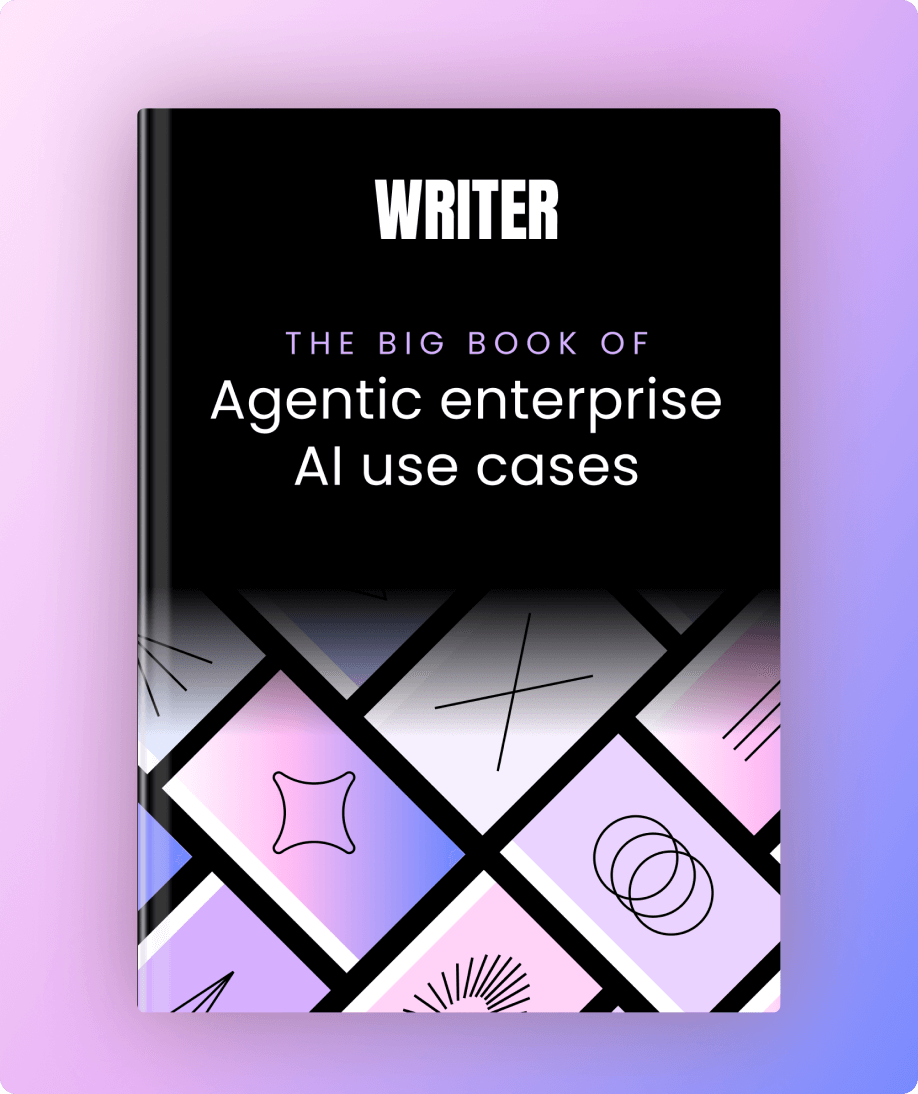
Download the ebook
Why agentic AI is the future of business process automation
As an enterprise leader, it’s important to understand the difference between completing a task and achieving a goal. AI agents for enterprises help achieve goals. Their impact on business process automation with AI is immense. They boost operational efficiency, cut costs, and speed up time-to-market by freeing your human teams to focus on the big picture.
The benefits are clear:
1. True scalability
With agentic AI, you’re not just boosting individual productivity — you’re automating entire departmental functions. Instead of just helping one salesperson pen better emails, you can create an agent that steers the whole lead qualification and follow-up process for the entire team.
2. Cross-functional power
Business goals rarely stay within one department. Agentic AI breaks down operational silos by creating agents that can orchestrate workflows across marketing, sales, HR, and IT. An agent can pull data from a sales CRM, use it to inform a marketing campaign, and then route budget requests through the finance department’s approval system.
3. Strategic focus
Your most valuable employees shouldn’t be consumed by managing complex processes. By automating these workflows, you free up your best people to concentrate on high-level strategy, innovation, and building customer relationships — the work that truly drives long-term growth.
The human element: Your strategic role in an agentic world
The rise of agentic AI doesn’t sideline humans — it invites us into a new, more powerful partnership. This isn’t about delegating our grunt work to a machine. It’s about co-creation.
In this partnership, we’re the visionaries. We’re the ones who provide the strategic intent, the ethical compass, and the deep understanding of human needs. The AI agent, in turn, becomes a force multiplier for our vision. It can analyze data at a scale we can’t, identify patterns we might miss, and even generate novel, creative strategies that we can then refine. It’s a symbiotic relationship where our strategic and empathetic intelligence increases through AI’s speed, scale, and computational creativity. We’re not just handing off tasks — we’re collaborating with a new kind of mind to achieve outcomes that were previously unimaginable.
Think of it this way — if an AI agent is a highly skilled specialist, you’re the project lead. You set the vision, define what success looks like, and provide the critical context that ensures the work aligns with the bigger picture. An agent might be able to execute a marketing campaign, but it needs a human to decide that the campaign’s goal is to break into a new market segment, and that the brand’s tone should be witty and empathetic, not formal and corporate.
This is where the idea of “human-led creativity” really shines. There’s an inherent value we place on ideas that come from people. Knowing a brilliant campaign concept originated from a team member, or that a new feature was inspired by a real user’s feedback, makes it more meaningful than something an algorithm generated in a vacuum. AI is an incredible tool for brainstorming and execution, but the spark of true, human-centric innovation remains indispensable.
In an agentic workflow, humans play several key roles:
- The strategist: You define the “why” behind the work. You set the business goals, identify the target audience, and establish the key performance indicators (KPIs) that measure success.
- The context-provider: AI agents are powerful, but they don’t have your institutional knowledge or your understanding of market nuances. You provide the essential background information, brand guidelines, and strategic guardrails that keep the agent on track.
- The conductor: Just like a conductor leading an orchestra, you orchestrate the work of multiple AI agents, ensuring they work in harmony to achieve a complex objective. You’re the one who knows which “instruments” to bring in and when.
- The final approver: Ultimately, you’re the one who gives the final sign-off. You use your judgment and experience to review the AI’s output, ensuring it meets the quality standards and strategic goals you’ve set.
Understanding levels of agentic autonomy
Not all AI agents are created equal. To understand what’s possible today versus what’s coming tomorrow, it’s helpful to understand the four levels of agentic autonomy:
End-to-end enterprise solutions require a mix of deterministic and non-deterministic work
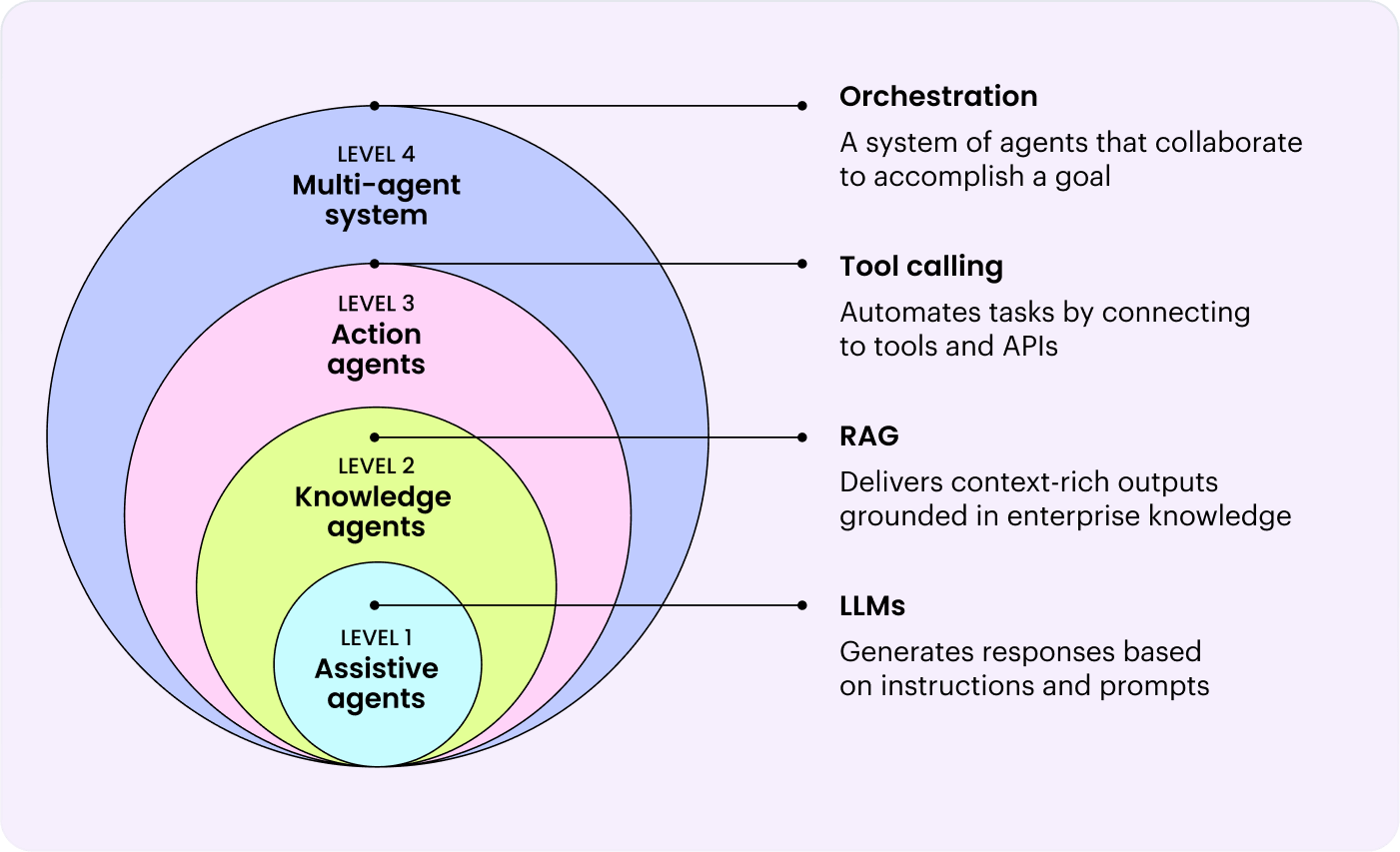
1. Assistive agent
Automates simple, prompt-based tasks. Ideal for recapping information or generating FAQs. This level offers a productivity boost for individual, repetitive tasks, but lacks the ability to interact with external systems.
2. Knowledge agent
Delivers context-rich answers by securely accessing internal knowledge bases using retrieval-augmented generation (RAG). It acts as an expert conversational partner, providing reliable information grounded in your company’s data.
3. Action agent
Executes complex tasks by connecting to external tools and APIs, enabling actions like sending emails, updating Salesforce records, or publishing content. These agents can autonomously carry out multi-step processes that directly impact business operations.
4. Multi-agent system
A network of specialized agents that collaborate to manage complex, end-to-end workflows, such as a full procurement process. This represents the pinnacle of agentic AI, where a team of agents works in concert to achieve high-level business goals with minimal human intervention.

AI agents in the
enterprise
Learn more
A warning on “agent washing”
As you explore the world of automation and AI, be aware of a misleading trend — “agent washing.” This is the practice of rebranding basic automation as “AI-powered” or misrepresenting simple assistive agents as action agents. It’s like calling a microwave a “culinary robot.” Not only does this create confusion, but it also leads enterprises to invest in solutions that don’t deliver on their promises.
Watch out for these red flags:
- Vague promises of “AI-powered” capabilities: Be wary of claims that sound too good to be true. Look for specific details about what the technology can and can’t do.
- Lack of transparency about autonomy levels: Legitimate AI solutions will clearly explain their level of autonomy and decision-making capabilities.
- No mention of failure modes or human oversight: Reputable providers will acknowledge potential failure points and explain how they address them through human oversight or other safety nets.
By understanding the distinct levels of agentic autonomy and recognizing the indicators of agent washing, you can make informed technology decisions and avoid costly pitfalls.

Enterprise guide to agent washing: Avoid million-dollar AI agent mistakes
Learn more
The agentic AI capabilities framework: A universal lens for your business
Before we dive into departmental examples, let’s establish a simple, agnostic framework. This will help you categorize opportunities and understand the fundamental capabilities of AI agents, regardless of where they are deployed. Most agentic workflows revolve around one or more of these four core functions.
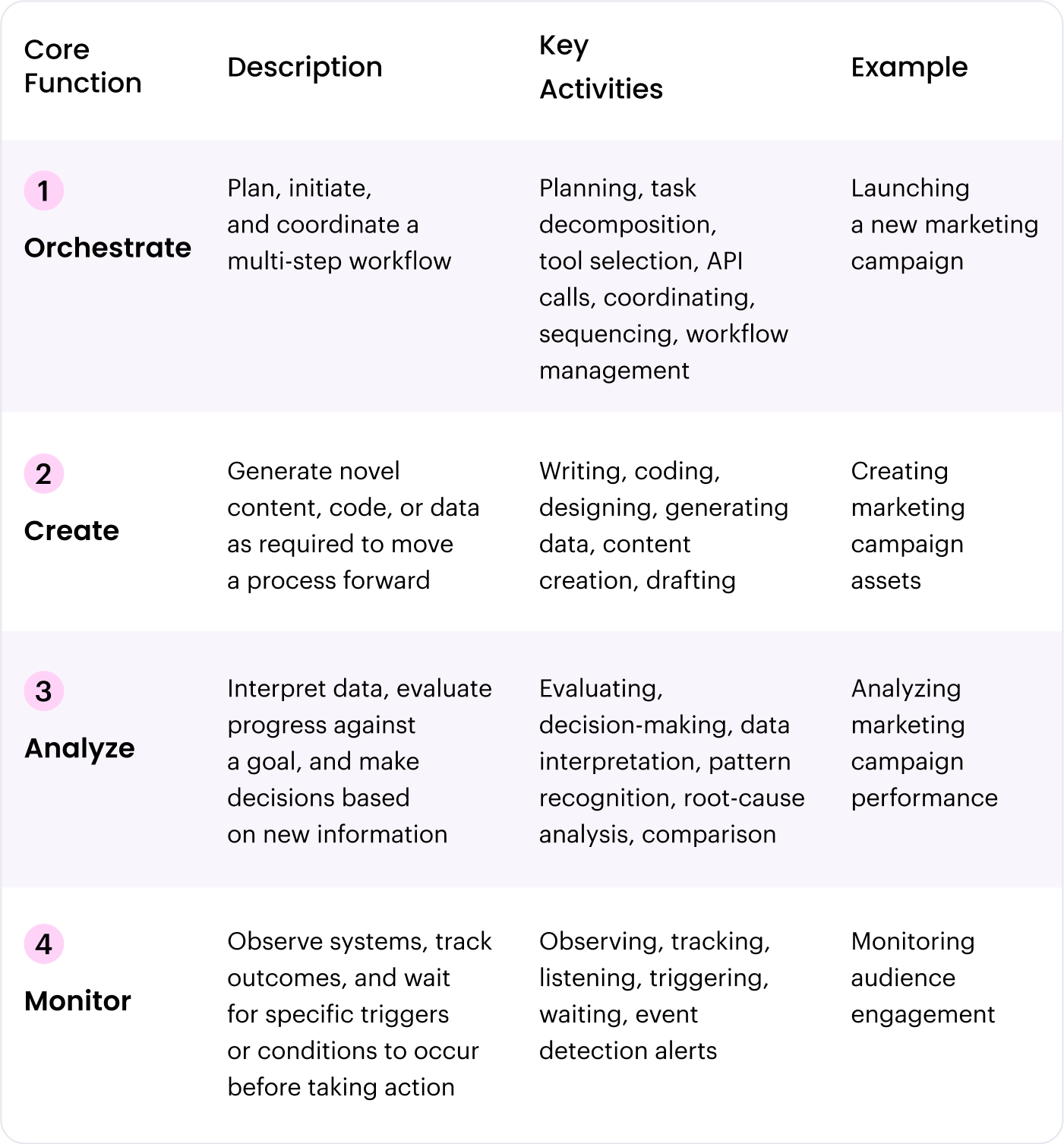
1. Orchestrate
Orchestration is the “project manager” function of the AI agent. It involves the ability to plan, initiate, and coordinate a multi-step workflow that may span multiple tools, systems, and even human inputs. The agent deconstructs a high-level goal into a sequence of concrete actions and ensures they get done in the correct order.
- Planning: Creating a detailed plan to achieve the high-level goal.
- Task decomposition: Breaking down complex tasks into smaller, manageable actions.
- Tool selection: Identifying the most appropriate tools and systems to use for each step.
- API calls: Interacting with various APIs to integrate different tools and systems.
- Coordinating: Ensuring all steps and actions are synchronized and executed efficiently.
- Sequencing: Arranging tasks in the correct order to optimize the workflow.
- Workflow management: Overseeing the entire process from start to finish.

An AI agent tasked with “launching a new marketing campaign” would begin by orchestrating the entire process. It would:
- Create a plan: Outline the key steps and milestones for the campaign.
- Schedule content creation: Coordinate with content creators to ensure timely production of materials.
- Identify platforms: Determine the most effective channels (email, social media, etc.) for reaching the target audience.
- Coordinate with tools: Integrate with design tools for creating visuals and analytics tools for tracking performance.
- Execute in sequence: Ensure each step follows the right order, from initial planning to final analysis.
This comprehensive approach guarantees that the marketing campaign launches smoothly and efficiently, relying on the strengths of both AI and human teams.
2. Create
Creation is the “generative engine” of the AI agent. This is where the agent generates novel content, code, or data as required to move a process forward. It uses the power of large language models to produce human-like output that’s contextually relevant to the task at hand.
- Writing: Producing human-like text for emails, articles, and social media posts.
- Coding: Generating functional code snippets or entire scripts to automate tasks or build components.
- Designing: Creating visual concepts, layouts, or simple design assets for marketing materials.
- Generating data: Producing structured or unstructured data for testing, analysis, or populating systems.
- Content creation: Developing a wide range of materials, from initial drafts to polished, ready-to-publish assets.
- Drafting: Preparing initial versions of documents, reports, or communications for human review.

In practice
Continuing the marketing campaign example, the agent would create the actual assets. It would:
- Write email copy: Draft compelling and persuasive copy for the email marketing blast.
- Generate social media posts: Create a series of engaging posts tailored to different platforms like Twitter, LinkedIn, and Instagram.
- Draft a blog article: Produce a comprehensive blog article that supports the campaign’s theme and incorporates SEO keywords.
- Create visual concepts: Suggest design templates or generate simple visual assets for the campaign’s look and feel.
This generative capability guarantees quick and consistent content production, accelerating the campaign’s time to market and freeing up human teams to focus on strategy and refinement.
3. Analyze
Analysis is the “critical thinking” function of the agent. It’s the ability to interpret data, evaluate progress against a goal, and make decisions based on new information. This is what allows the agent to be adaptive and responsive, rather than blindly following a static script. It can identify patterns, understand cause-and-effect, and choose the best path forward.
- Evaluating: Assessing performance, quality, or progress against predefined metrics and goals.
- Decision-making: Choosing the optimal course of action from multiple alternatives based on data and analysis.
- Data interpretation: Translating raw data (like numbers and text) into actionable insights and meaningful conclusions.
- Pattern recognition: Identifying trends, anomalies, or recurring sequences within datasets to predict future outcomes or flag issues.
- Root-cause analysis: Investigating a problem to find the fundamental underlying reason, not just the surface-level symptoms.
- Comparison: Setting two or more datasets or outcomes side by side to determine their relative performance, such as in A/B testing.

In practice
Once the marketing campaign is live, the agent analyzes its performance. It would:
- Interpret performance data: Monitor and interpret key metrics continuously, like open rates, click-through rates, and conversion data across all channels.
- Identify performance gaps: Recognize that the campaign is underperforming on a specific channel compared to its initial targets or other channels.
- Decide on corrective actions: Decide, based on the data, to automatically reallocate the budget to better-performing channels or initiate a new A/B test on subject lines to improve the results.
This analytical capability transforms the agent from a simple executor into a strategic partner that actively learns from results and optimizes for better outcomes.
4. Monitor
Monitoring is the function that gives the agent persistence and awareness over time. It’s the ability to observe systems, track outcomes, and wait for specific triggers or conditions to occur before taking action. This allows the agent to operate in the background, ready to act when the moment is right.
- Observing: Actively watching digital environments, such as systems, dashboards, or data streams, for any changes or updates.
- Tracking: Following the status or progress of specific metrics, processes, or outcomes over a period of time, such as tracking a support ticket from creation to resolution.
- Listening: Continuously scanning unstructured data sources like social media feeds, customer reviews, or email inboxes for specific keywords, mentions, or sentiment.
- Triggering: Initiating a predefined action or workflow automatically when a specific condition or event is detected.
- Waiting: Pausing a workflow or process intelligently until a specific time, event, or external input occurs before proceeding.
- Event detection: Identifying the occurrence of a significant event within a stream of data, such as a system error, a new customer sign-up, or a specific user action.
- Alerts: Automatically notifying a human user or another system when a predefined threshold or a critical event happens.

In practice
The marketing agent continuously monitors audience engagement. It would:
- Listen for engagement signals: Actively scan social media for mentions of the campaign and track email replies to identify user sentiment and questions.
- Detect a trigger event: Identify a highly engaged user who has clicked on multiple links and posted a positive comment about the product.
- Trigger a follow-up action: Automatically send a personalized follow-up email with a special offer to that user, or alert a sales representative to a potential lead if a user asks a direct buying question.
This monitoring capability allows the agent to be proactive and responsive, engaging with users at the most opportune moments without constant human oversight.
Agentic AI use cases by department
The following examples aren’t single-task “prompts” but complete, automated workflows that an AI agent can execute with minimal human intervention.
To help organizations adopt these powerful capabilities responsibly, we’ve organized them into a strategic maturity framework: Crawl, Walk, Run, and Fly. This phased approach is essential for the enterprise because it provides a clear path to value while managing risk. Instead of pursuing a high-risk, “big bang” implementation, teams can begin with contained, high-impact workflows (Crawl) to build confidence and demonstrate ROI, before scaling to more integrated (Walk), fully autonomous (Run), and ultimately, business-transforming automations (Fly).
The following use cases demonstrate this potential across key enterprise functions — from finance and human resources to legal, marketing, sales, and support. In each department, agentic AI can drive significant impact by automating complex workflows, streamlining operations, and empowering teams to focus on high-value strategic work.
Finance
Finance teams face the challenge of balancing between growing business demands and manual processes that can’t scale. Every new customer contract requires careful review, every vendor invoice needs processing and approval, and every supplier relationship involves extensive documentation and onboarding procedures. While finance professionals manually chase contract approvals, hunt down missing purchase orders, and coordinate supplier evaluations, critical business opportunities slip through the cracks and cash flow becomes unpredictable. The expertise that should drive strategic financial planning gets consumed by administrative workflows that bottleneck the entire revenue and procurement cycle.
The agentic leap empowers finance teams by deploying intelligent AI agents that improve core financial processes automatically. By managing everything from contract analysis to supplier onboarding, these agents free finance professionals to focus on strategic analysis, relationship management, and the complex decision-making that actually drives business growth.
Here are three key finance use cases mapped to the Crawl, Walk, Run, Fly framework.
Quote-to-cash cycle automation
Every sales deal that contract reviews delay costs money, and every payment that takes weeks to collect hurts cash flow. The traditional quote-to-cash cycle is full of manual handoffs. Sales teams wait for contract approvals, finance teams manually review terms and pricing, and accounts receivable chase down payments with spreadsheets and phone calls. Each step creates delay and risk, from missed contract terms that impact profitability to payment collection inefficiencies that hurt cash flow. An autonomous quote-to-cash agent transforms this process by intelligently reviewing contract terms, streamlining approval workflows, and automating payment collection activities, creating a smooth revenue pipeline that accelerates cash conversion and reduces administrative overhead.
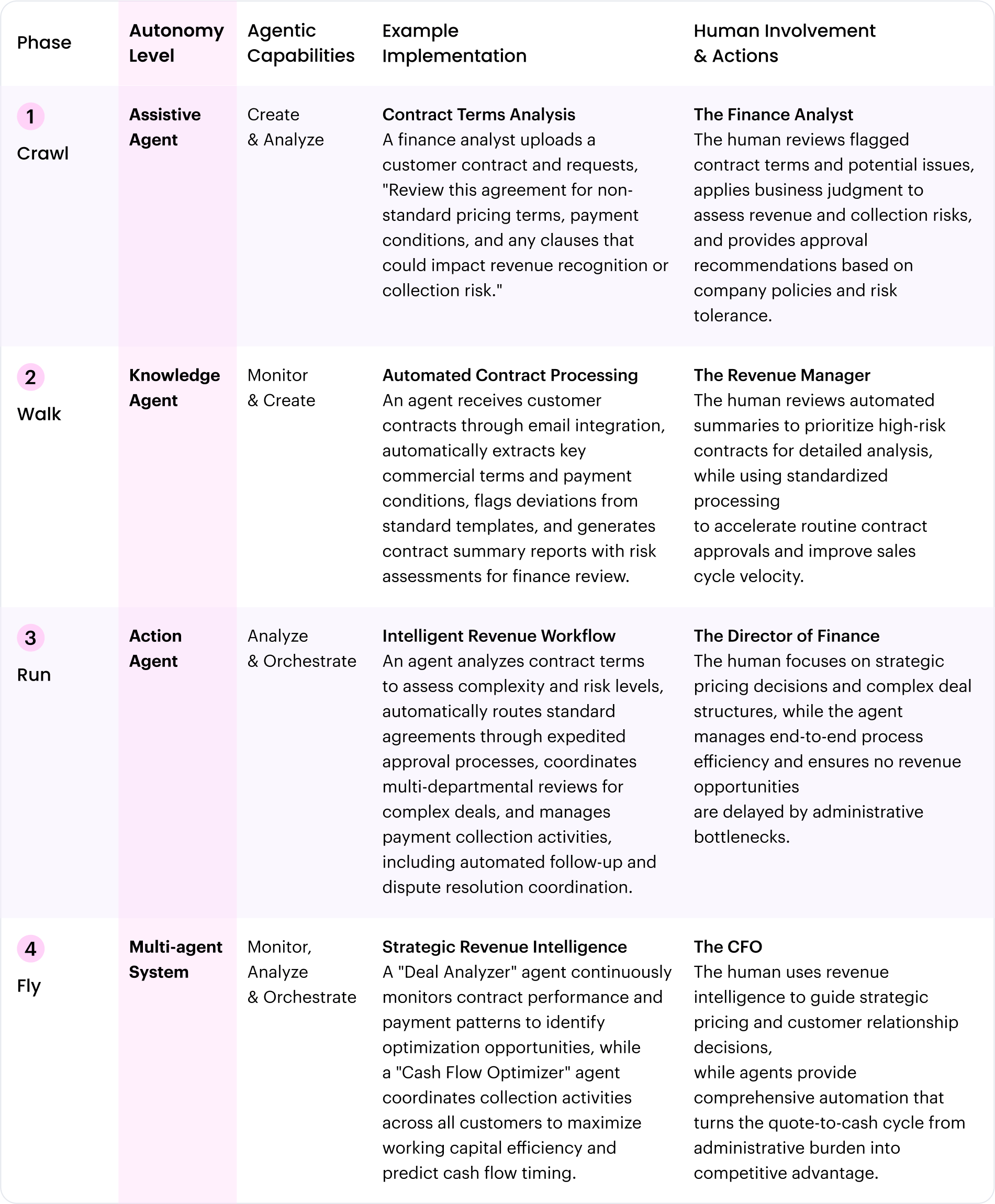
Accounts payable process augmentation
Late vendor payments strain relationships, duplicate invoices waste money, and manual processing errors create constant firefighting. Traditional accounts payable is error-prone and time-consuming — clerks manually enter invoice data, hunt down purchase orders for three-way matching, and coordinate approvals across multiple departments while vendors complain about payment delays. Each manual step creates the risk of duplicate payments, incorrect amounts, or missed early payment discounts. An autonomous AP agent eliminates these inefficiencies by intelligently processing invoices, automating approval workflows, and optimizing payment timing to improve vendor relationships while reducing processing costs and payment errors.
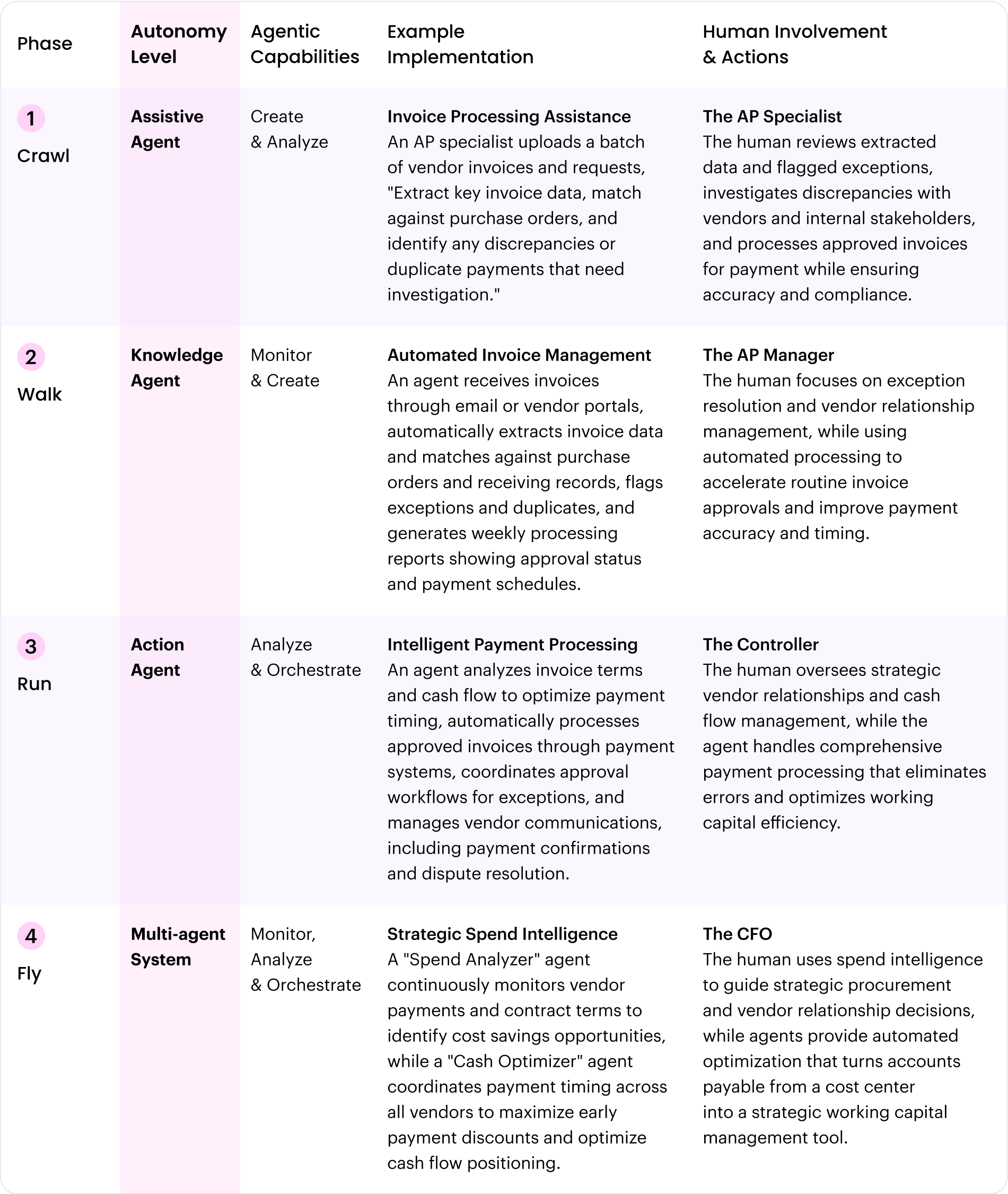
Sourcing and procurement optimization
When RFPs take months to complete and supplier onboarding drags on indefinitely, business momentum dies. Traditional sourcing is inefficient and frustrating — procurement teams manually create RFP documents, wait weeks for supplier responses, and spend countless hours evaluating proposals and coordinating supplier setup across multiple systems and departments. Meanwhile, business stakeholders grow impatient with slow procurement cycles that delay critical projects and limit operational flexibility. An autonomous procurement agent streamlines this entire process by intelligently managing RFP creation and evaluation, accelerating supplier onboarding, and providing strategic insights that improve sourcing decisions and supplier relationship management.
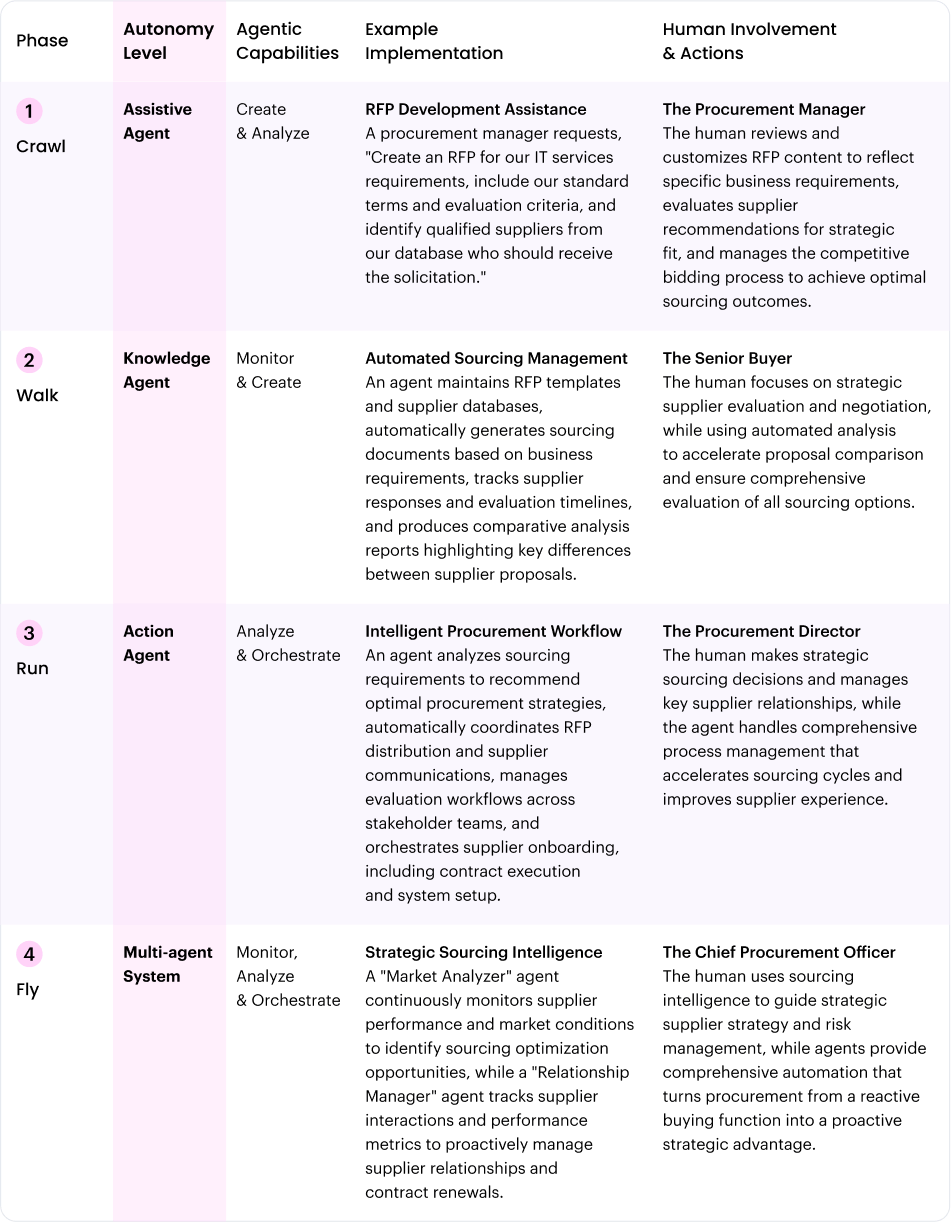
Strategic guardrails for agentic finance teams
To successfully integrate agentic AI into your finance operations, you must pair the pursuit of efficiency with an unwavering commitment to accuracy and fiduciary duty. These guardrails ensure technology enhances financial integrity, rather than compromising it.
- Own the forecast
Unquestionably accepting an agent’s financial models or strategic recommendations abdicates professional responsibility
Action: Treat the agent’s output as a powerful input to your analysis, not the final word. The finance professional is always accountable for the final judgment. - Validate every number
An agent can misinterpret data or hallucinate figures, leading to flawed financial reporting and catastrophic business decisions
Action: Implement a “human-in-the-loop” verification process for all critical outputs, from internal reports to external filings. - Secure the vault
An agent with access to financial systems is a prime target for security breaches and can expose material non-public information (MNPI)
Action: Enforce the principle of least privilege, granting the agent access only to the data and systems essential for its specific, approved tasks. - Maintain an audit trail
AI-driven financial processes can become “black boxes,” making regulatory compliance and audits (like for SOX) impossible
Action: Ensure the agent maintains an immutable, detailed log of all its operations, data sources, and calculations for full transparency and auditability.
The bottom line: Use agentic AI to illuminate financial data, not to dictate financial strategy.
Case study
FINANCEHow a global semiconductor leader automated its complex supply chain payments
For a global semiconductor giant, the accounts payable (AP) department was buried under a mountain of manual work, processing tens of thousands of multi-currency invoices each month. This grueling process created significant risk — a delayed payment to a key foundry could disrupt the entire supply chain, and the company was consistently missing out on early-payment discounts. The team was trapped in a cycle of clerical work, unable to focus on financial strategy.
The solution was an assistive agent that reads PDF invoices to intelligently extract key data. When an AP specialist received an invoice, the agent would pre-populate the fields for vendor name, invoice number, and amount. Instead of starting from scratch with manual data entry, the team began with a foundation of accurate, structured data.
This journey maps directly to the Crawl, Walk, Run, Fly framework:
- Crawl: The process started with a Content Agent used to extract and structure data from invoices. The AP specialist, acting as the “Validator,” simply confirmed the agent’s work instead of typing it in.
- Walk: The system evolved to include a Knowledge Agent that automatically ingested invoices and cross-referenced them against purchase orders. The AP team, acting as “Exception Handlers,” focused only on investigating flagged discrepancies.
- Run: The next stage introduced an Action Agent that orchestrated the entire approval and payment-scheduling workflow. The AP Manager, acting as the “Process Supervisor,” was freed up to oversee the automated system’s performance.
- Fly (The Vision): The Future Vision is a Multi-agent System where the AP agent collaborates with Supply Chain and Sourcing agents to optimize cash flow. The Director of Finance, acting as the “Strategist,” uses these cross-functional insights to improve working capital.
By turning a manual process into an autonomous one, the company reduced invoice processing time by 90%, captured an additional $15 million annually in early payment discounts, and reallocated 80% of the AP team’s time from tedious data entry to high-value strategic analysis.
Human Resources
HR teams are drowning in administrative overhead. Between answering the same benefits questions for the hundredth time, manually tracking down missing onboarding documents, and trying to coordinate performance reviews across dozens of managers, there’s barely time left for the work that actually moves the needle — developing talent, improving culture, and solving complex people challenges. This administrative burden doesn’t just slow down HR operations — it actively prevents the strategic, human-centered work that drives retention and engagement.
The agentic leap empowers HR teams by deploying intelligent AI agents that handle routine workflows automatically. By managing everything from candidate screening to performance tracking, these agents free HR professionals to focus on high-value relationship building and strategic initiatives, transforming the entire employee experience.
Here are three key HR use cases mapped to the Crawl, Walk, Run, Fly framework.
Candidate sourcing and research
Great talent doesn’t wait around while your team manually sifts through hundreds of resumes. By the time your recruiters have screened the obvious nos and maybes, that perfect candidate has already accepted an offer from a competitor who moved faster. This isn’t just about efficiency — it’s about losing top talent to slower processes. An autonomous recruiting agent changes the entire game by working as your 24/7 talent scout and research assistant. It continuously searches across multiple channels, enriches candidate profiles with relevant information, and organizes everything for human review before they’re even thinking about other opportunities. This transforms your hiring from reactive to proactive, ensuring you’re always first in line for the best talent.
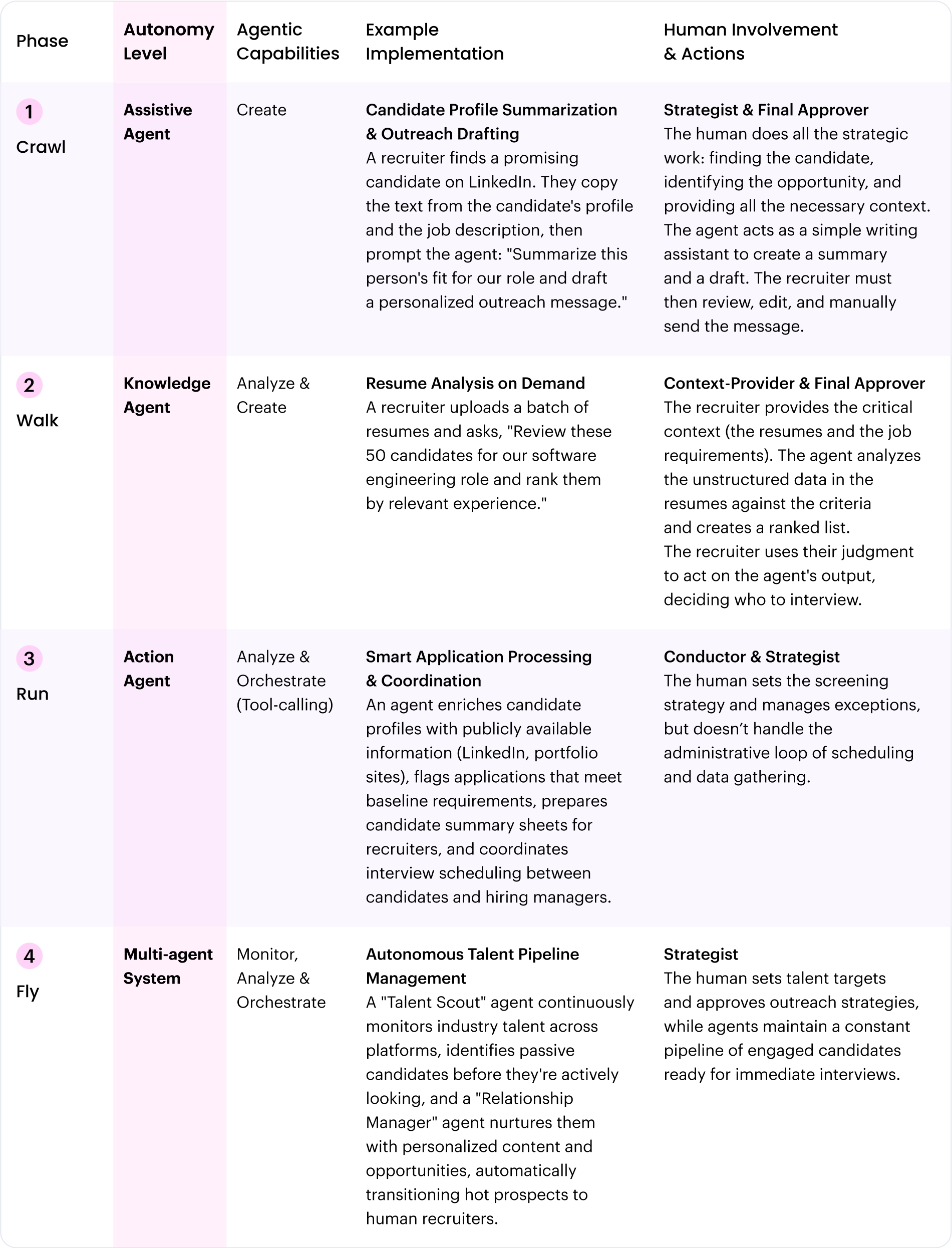
Employee onboarding and training
A new hire’s first week shapes their entire relationship with your company, but most onboarding feels like drinking from a firehose of disconnected tasks and forgotten follow-ups. While your new employee sits confused about where to find basic information, your HR team is juggling twenty other urgent priorities, and that critical first impression becomes a missed opportunity. An autonomous onboarding agent ensures no new hire falls through the cracks by orchestrating their entire journey from offer acceptance to productive team member. It personalizes each step based on role and department. Plus, it proactively delivers information before it’s needed, and continuously checks in to address concerns. This transforms onboarding from a chaotic checklist into a smooth, engaging experience that sets employees up for long-term success.
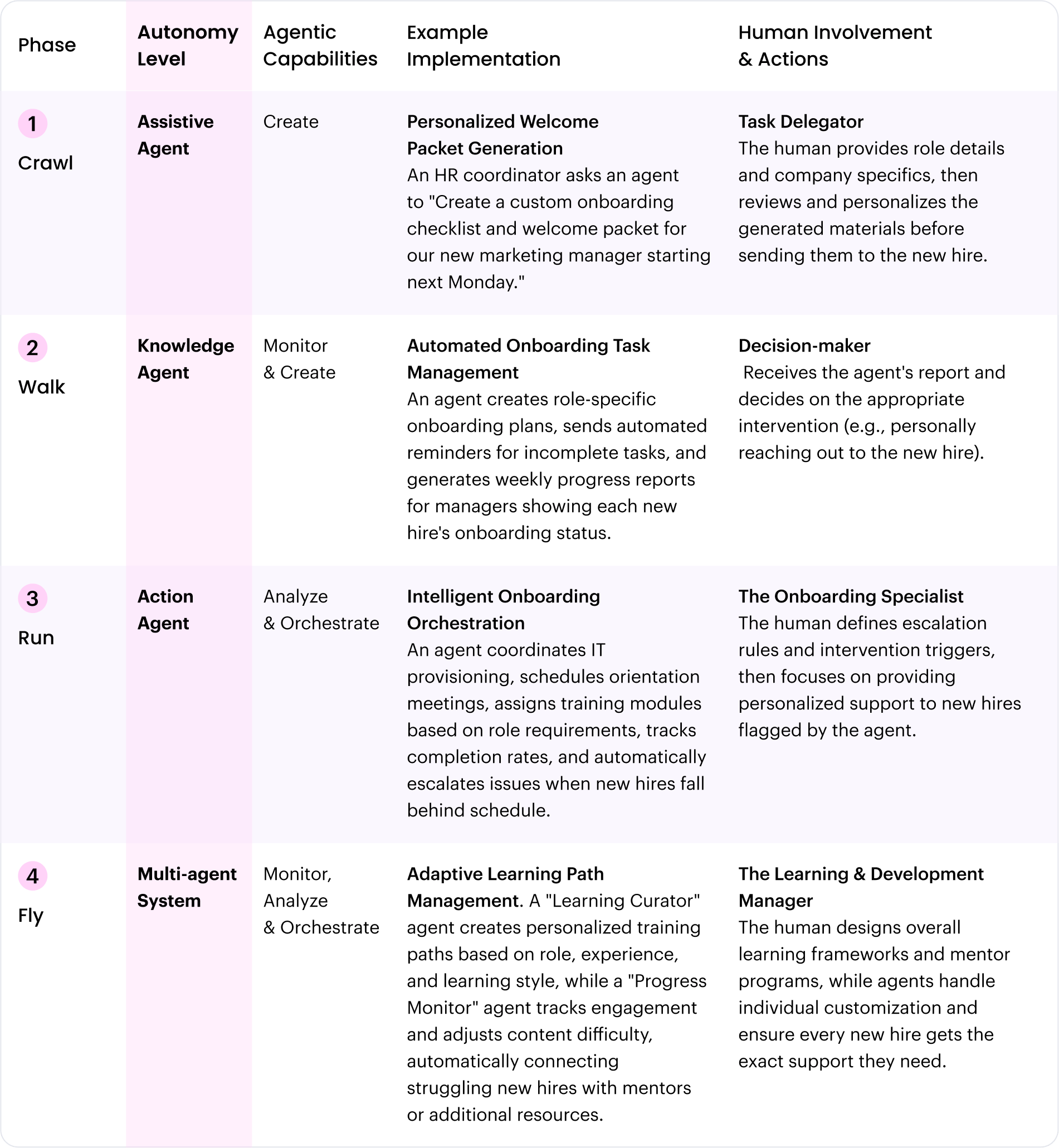
Performance management and feedback
Annual performance reviews are where good intentions go to die. By the time your team sits down for that “important” conversation, the feedback is months old, the context has faded, and the moment for real impact has passed. Meanwhile, high performers are quietly disengaging because no one noticed their wins, and struggling employees aren’t getting the support they need until it’s too late. An autonomous performance agent transforms this broken cycle by capturing feedback and achievements in real time, identifying patterns and concerns as they emerge, and ensuring managers have the context and insights they need for meaningful conversations. This shifts performance management from an annual chore to a continuous, data-driven process that actually develops people and drives results.
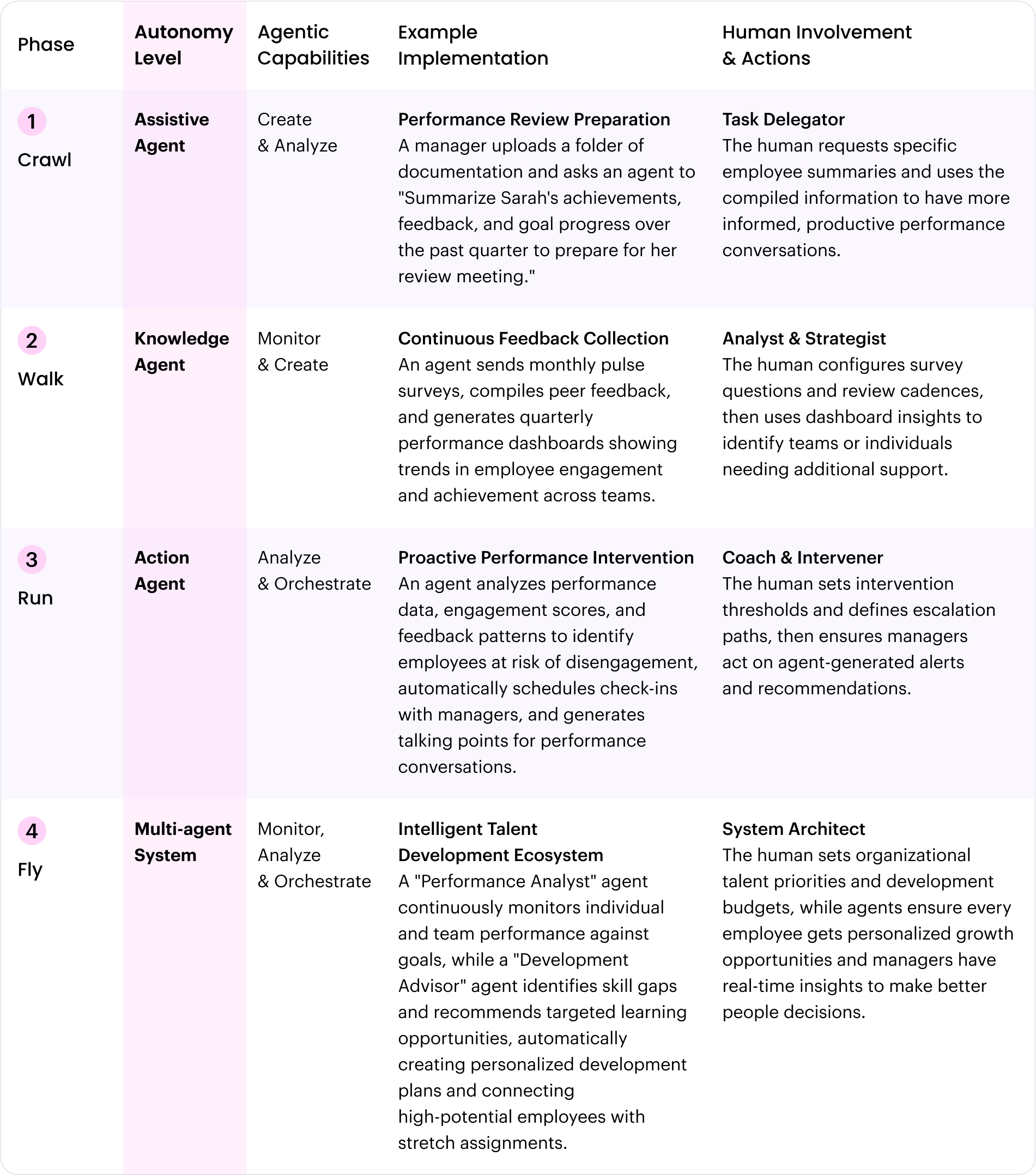
Strategic guardrails for agentic HR
To fully realize the power of agentic AI in HR, balance ambition with responsibility. These guardrails ensure technology serves your team, your candidates, and your company — not the other way around.
- Audit for bias
An agent will amplify any bias present in your historical data
Action: Continuously audit training data and model outputs to ensure equitable outcomes. - Preserve the human element
Automate transactional tasks, not foundational relationships
Action: Keep human judgment at the center of high-stakes decisions like hiring, promotions, and terminations. - Uphold data privacy
An agent with broad access is a new vector for data risk
Action: Implement strict, role-based data access controls for the agent, just as you would for a human employee. - Maintain human oversight
Never cede final authority to a machine
Action: Treat the agent as a powerful advisor, not the ultimate decision-maker. You’re always accountable.
The bottom line: Use agentic AI to augment your judgment, not replace it.
Case study
HUMAN RESOURCESHow a growing tech company solved the self-review problem
For many companies, performance reviews are exercises in frustration. At a 500-person technology company, HR watched self-review completion rates stall at 60%. The problem wasn’t disengagement — it was the dreaded blank page. Employees wanted to reflect on their growth, but staring at open-ended questions left them paralyzed, unable to recall specific details from months ago.
The solution was an assistive agent that helps employees draft their self-review responses by analyzing their existing work. When an employee begins their review, the agent pulls from 1:1 meeting notes, project reports, and positive Slack mentions to suggest specific accomplishments. Instead of starting from scratch, employees begin with a foundation of their actual work.
This journey maps directly to the Crawl, Walk, Run, Fly framework:
- Crawl: The process started with an Assistive Agent used to create and analyze content for a self-review. The employee, acting as the “Reflector,” prompts the agent for a draft and then adds their own personal context and insights.
- Walk: The system evolves to include a Knowledge Agent that continuously monitors employee activities (like project completions) to maintain an “achievement log.” The manager, acting as the “Coach,” receives richer, more detailed reviews and can focus conversations on development.
- Run: The next stage introduces an Action Agent that analyzes and orchestrates the review workflow. It can prompt employees for more details or coordinate peer feedback requests. The HR Business Partner, acting as the “Calibrator,” is freed up to focus on strategic support.
- Fly (The Vision): The Future Vision is a Multi-agent System that monitors, analyzes, and orchestrates the entire performance ecosystem. A “Growth Tracker” agent could identify skill opportunities, while a “Culture Monitor” agent surfaces organizational trends. The Chief People Officer, acting as the “Strategist,” uses these insights to drive systemic improvements.
By simply helping employees remember and articulate their own work, the company transformed a dreaded task into a meaningful reflection exercise, boosting completion rates to 95% and giving managers better data for development conversations.
Legal
Legal teams shouldn’t be the bottleneck that slows down business innovation. Every day, contracts pile up waiting for review, marketing teams submit claims that need legal approval, and employees across the organization interrupt lawyers with basic compliance questions that could get instant answers. Meanwhile, legal professionals spend their expertise reading through lengthy legislative updates and comparing document versions line by line — work that’s critical but doesn’t require their strategic legal judgment. The result is a legal function that’s always reactive, always behind, and never able to focus on the high-value counsel that actually drives business success.
The agentic leap empowers legal teams by deploying intelligent AI agents that handle routine document analysis and content review automatically. By managing everything from contract reviews to compliance content creation, these agents free legal professionals to focus on strategic counsel, complex negotiations, and the nuanced legal analysis that requires human expertise.
Here are three key legal use cases mapped to the Crawl, Walk, Run, Fly framework.
Document review and analysis
Legal teams spend days reading through hundreds of pages just to find the handful of clauses that matter. Traditional document review is like searching for needles in haystacks — attorneys manually scanning contracts for specific terms, comparing document versions word by word, and trying to synthesize key insights from lengthy legislative updates or earnings transcripts. This manual process doesn’t just waste time — it creates risk when important details get missed in the volume of text. An autonomous document analysis agent transforms this process by instantly scanning documents for specific terms, flagging unusual provisions, and summarizing key insights. It doesn’t replace legal judgment, but it ensures that legal professionals can focus their expertise on analysis and strategy rather than manual reading and comparison.
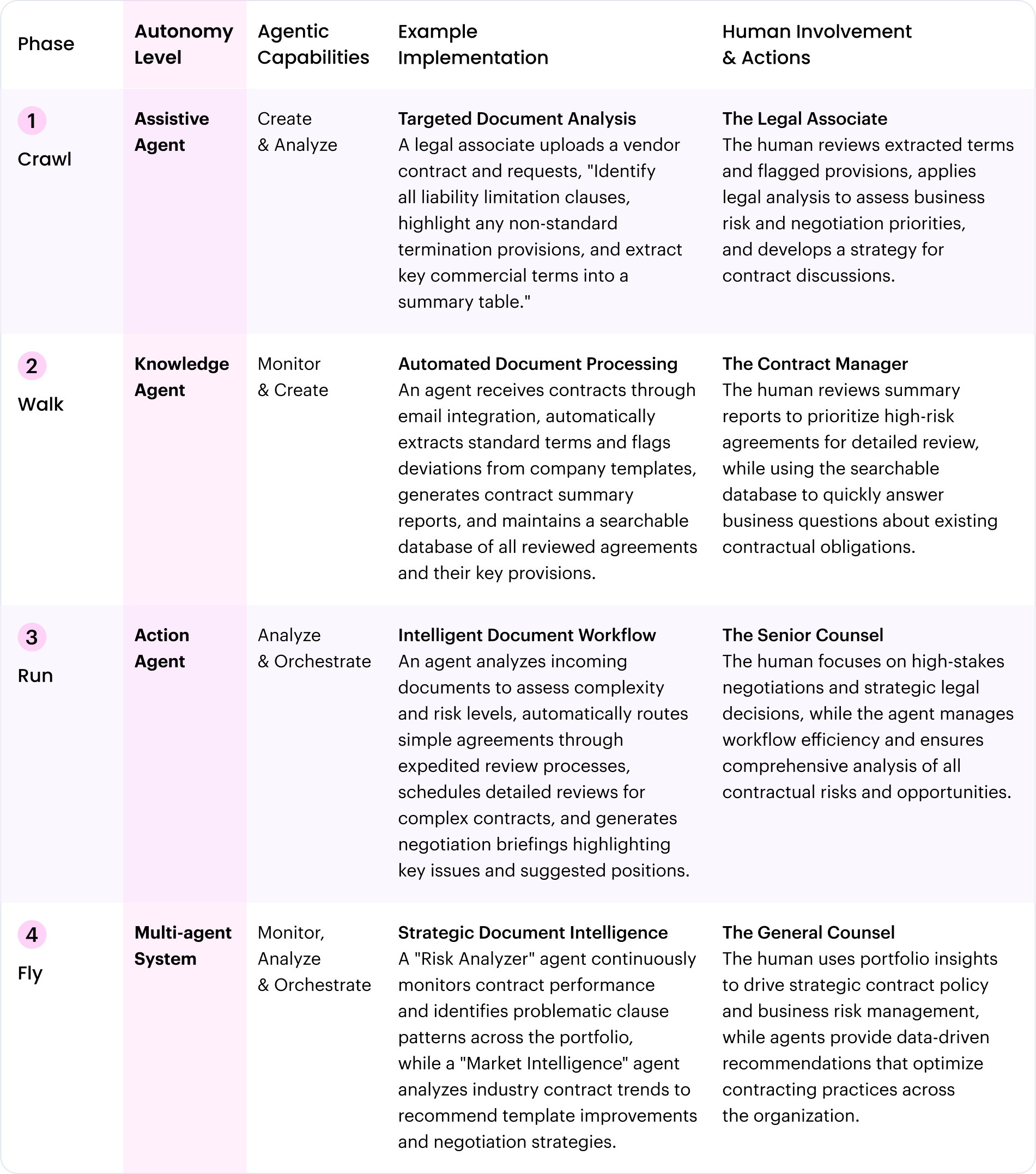
Compliance content creation and review
Marketing teams shouldn’t have to wait days for legal approval on routine content, and legal teams shouldn’t spend their time reviewing the same types of compliance language over and over. The current process creates frustration on both sides — marketing feels blocked by legal bottlenecks, while legal teams feel overwhelmed by requests to review content that follows standard patterns. Most of these reviews involve checking that claims are substantiated, required disclaimers are included, and language aligns with regulatory requirements — work that’s important but highly repetitive. An autonomous compliance agent transforms this dynamic by providing real-time guidance on compliant language, automatically flagging problematic claims, and enabling self-service compliance tools that let non-legal teams create content that meets legal standards from the start.
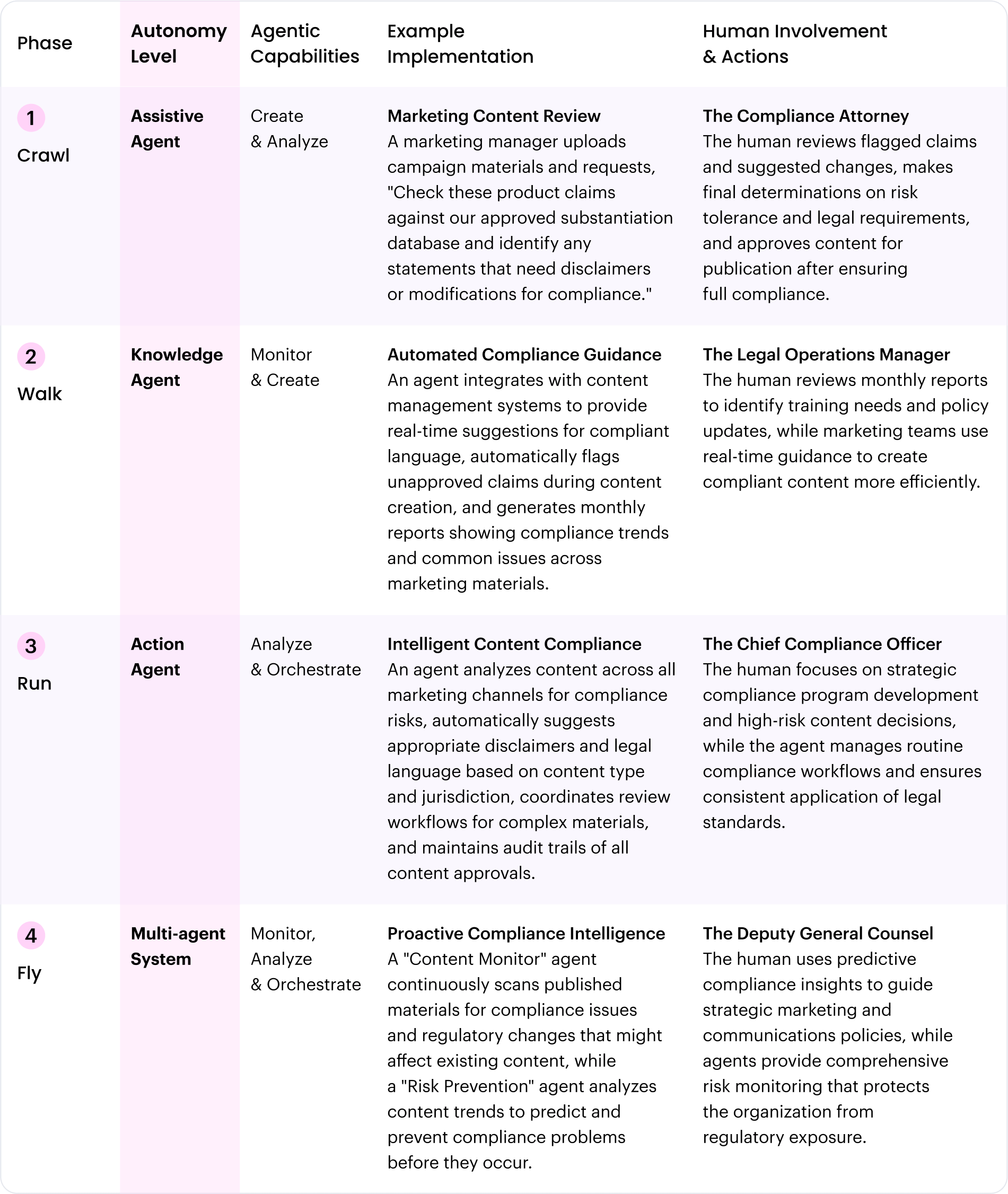
Legal knowledge management and self-service
Legal teams often act as the answer desk for every basic compliance question in the organization. When employees interrupt attorneys to ask about standard HR policies, routine contract terms, or basic regulatory requirements, it makes both sides inefficient. Employees wait for answers they need right now. Legal experts can’t do the complex work that requires their expertise. The old way of telling people to look at legal handbooks or policy documents doesn’t work because most employees can’t find or understand the information they need. An autonomous legal knowledge agent creates a self-service solution that provides instant, accurate answers to common legal questions while escalating complex issues to appropriate legal professionals.
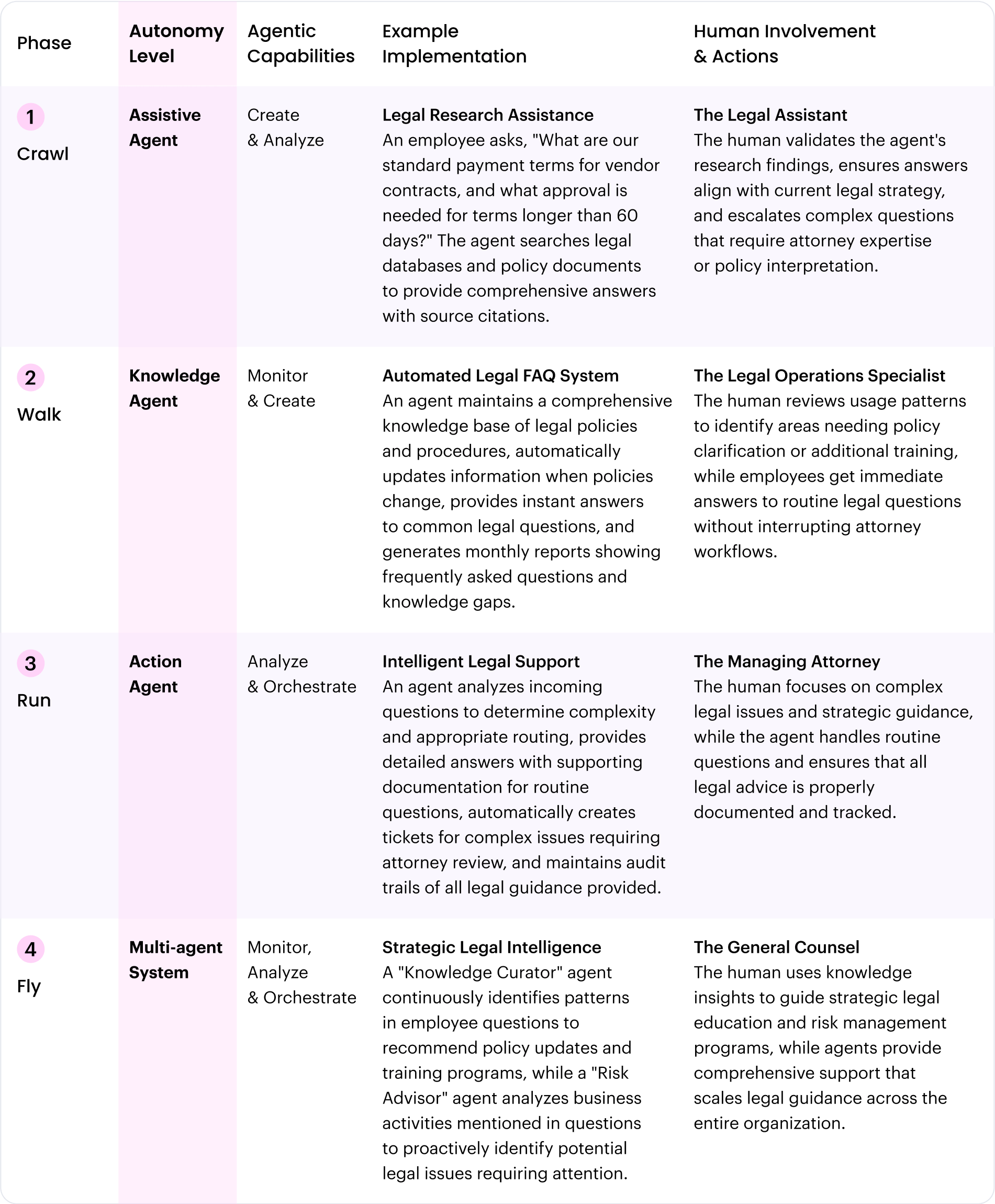
Strategic guardrails for agentic legal teams
To successfully integrate agentic AI into your legal operations, you must pair the pursuit of efficiency with an unwavering commitment to confidentiality and risk mitigation. These guardrails ensure technology serves as a force multiplier for your legal experts, not a source of unmanaged liability.
- Secure the digital vault
An agent with access to legal documents can inadvertently break attorney-client privilege or expose sensitive case information.
Action: Enforce the principle of least privilege, operating the agent within a secure, sandboxed environment with strict access controls to uphold confidentiality. - Mandate verifiable sources
An agent pulling from the open internet can introduce inaccurate information or outdated precedents, leading to flawed legal analysis
Action: Require every agent-generated summary or answer to be explicitly tied to an approved source of truth, whether it’s a specific contract, internal policy, or legal statute. - Define the agent’s jurisdiction
Business users might interpret an agent’s output as official legal advice, creating significant liability for the company
Action: Clearly label all agent outputs as “preliminary” and “for informational purposes only,” with a disclaimer that they do not constitute legal advice and require human review. - Own the legal judgment
Unquestionably accepting an agent’s contract review or risk assessment abdicates the lawyer’s professional responsibility
Action: Treat the agent’s analysis as a first-pass, issue-spotting tool, with the human lawyer always retaining final accountability for legal advice and strategic decisions.
The bottom line: Use agentic AI to accelerate legal review, not to replace legal reasoning.
Case study
LEGALHow a global CPG giant ended the marketing-legal bottleneck
For a multinational consumer goods company with hundreds of iconic brands, every new ad, social media post, or packaging update created a massive logjam for the legal team. Marketing teams, under pressure to launch campaigns quickly, would submit thousands of assets for review, only to wait days for approval. The legal team, in turn, was buried in low-value, repetitive work — checking product claims against substantiation documents and ensuring the use of the right disclaimers across different countries. This friction not only slowed speed-to-market but also relegated the highly skilled legal team to the role of a reactive gatekeeper.
The solution began with an assistive agent designed to handle the first pass on all marketing content. When a brand manager submitted a new campaign asset, the agent would instantly scan the content, check every claim against a pre-approved substantiation database, and flag any language that deviated from legal standards. Instead of manually reviewing every word, the compliance attorney could now focus their expertise exclusively on the handful of flagged items that required true legal judgment.
This journey maps directly to the Crawl, Walk, Run, Fly framework:
- Crawl: The process started with a Content Agent that analyzed marketing materials against a compliance database. The Compliance Attorney, acting as the “Validator,” reviewed the agent’s flagged exceptions instead of the entire document.
- Walk: The system evolved to include a knowledge agent that integrated directly into the marketing team’s content creation tools, providing real-time compliance guidance as they wrote. The Legal Operations Manager, acting as the “Analyst,” reviewed compliance trend reports to identify areas for marketer training.
- Run: The next stage introduced an action agent that orchestrated the entire review workflow, automatically suggesting jurisdiction-specific disclaimers and routing only high-risk content for senior legal review. The Chief Compliance Officer, acting as the “Process Supervisor,” focused on strategic program development.
- Fly (The Vision): The Future Vision is a multi-agent system where a “Content Monitor” agent scans all live marketing assets for new regulatory risks, while a “Risk Prevention” agent analyzes content trends to predict and prevent compliance issues. The Deputy General Counsel, acting as the “Strategist,” uses these predictive insights to guide global marketing policy.
By transforming its marketing review process, the company reduced the average legal review time for routine assets from five days to just four hours. This shift enabled the marketing team to launch campaigns 40% faster and freed up over 10,000 hours of legal team time annually, allowing them to transition from a bottleneck to a strategic partner in driving business growth.
Marketing
Marketing teams often have to act as manual data wranglers, spending their days piecing together fragmented information from dozens of different tools. Every campaign requires them to manually pull reports from analytics platforms, stitch together customer data from the CRM, and track user behavior across the website, social media, and email. This constant, low-level data manipulation means that by the time an insight is found, the opportunity to act on it has often passed. As a result, marketers are buried in operational tasks, unable to focus on the creative and strategic work that drives real business growth.
The traditional solution of buying more specialized marketing software often makes the problem worse, creating even more data silos and dashboards that fail to connect the dots of a complex customer journey. Relying on static reports only shows what has already happened, offering little guidance on what to do next to influence future outcomes. An autonomous marketing agent acts as the central nervous system for the entire marketing ecosystem. It connects disparate data sources, proactively analyzes performance to surface growth opportunities, and automates the execution of complex, multi-channel campaigns, allowing marketers to move from being reactive data analysts to proactive strategists.
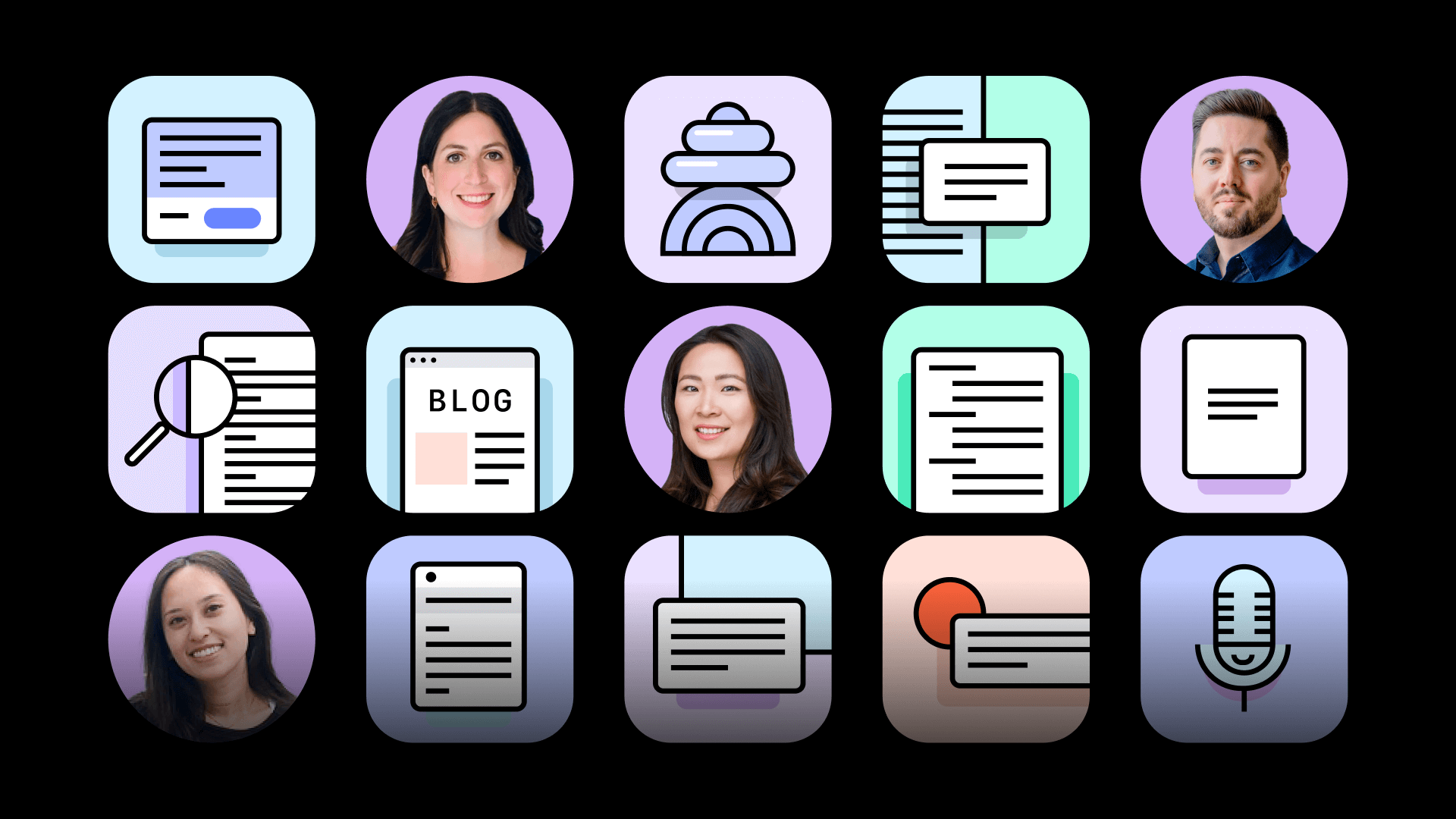
Agentic AI for marketing teams
Learn More
Performance marketing optimization
Marketing teams often struggle to manually manage campaigns across multiple platforms, leading to inefficient ad spend and missed opportunities. This framework provides a phased path to deploying an agentic AI system that automates campaign creation, analysis, and real-time budget optimization.
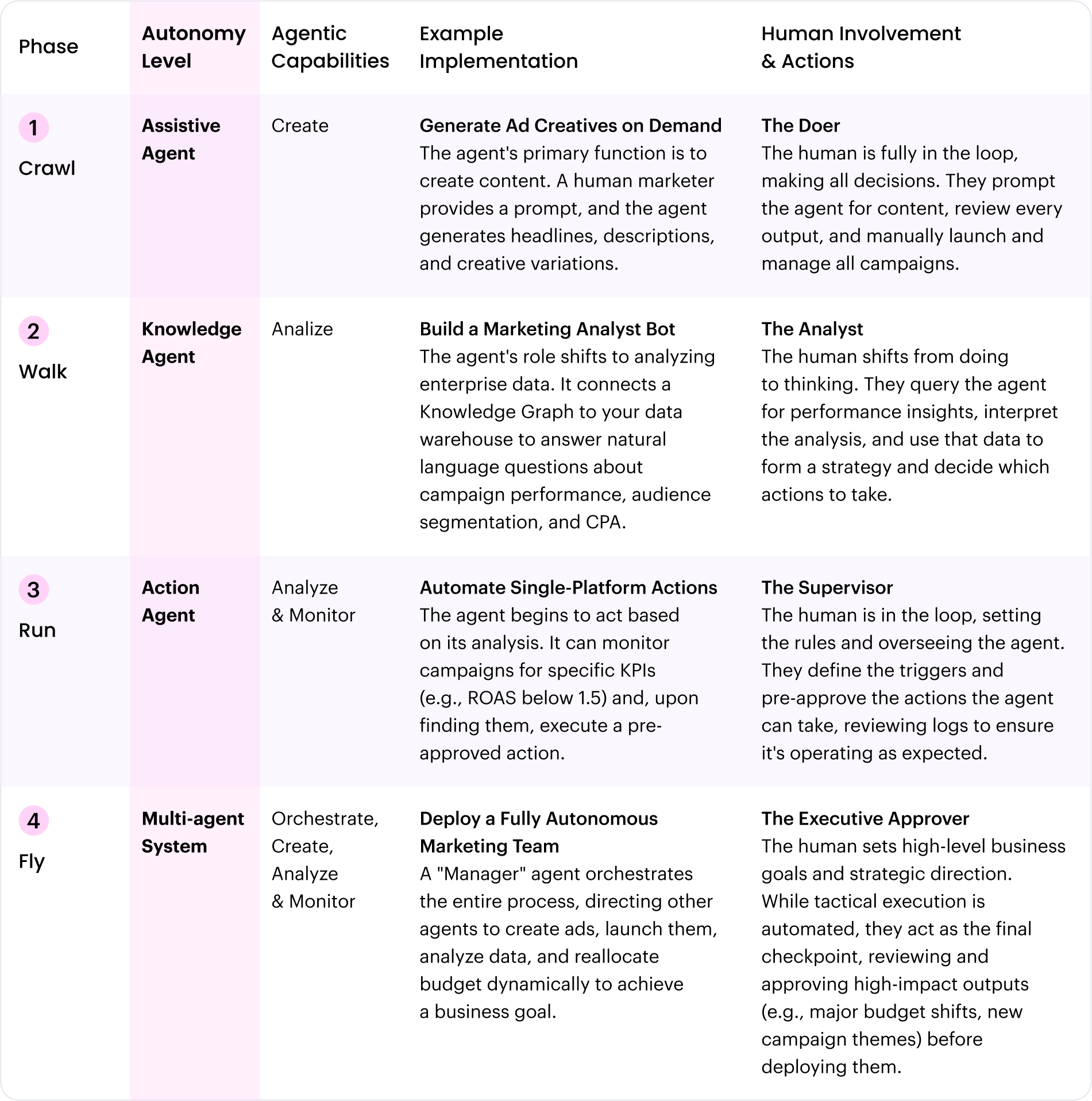
Generative Engine Optimization (GEO)
As AI-driven search engines continue to revolutionize the way we find information online, businesses risk losing control of their brand narrative on external platforms. This framework details how to build an agentic system that proactively monitors, manages, and optimizes your company’s presence in these new generative engines.
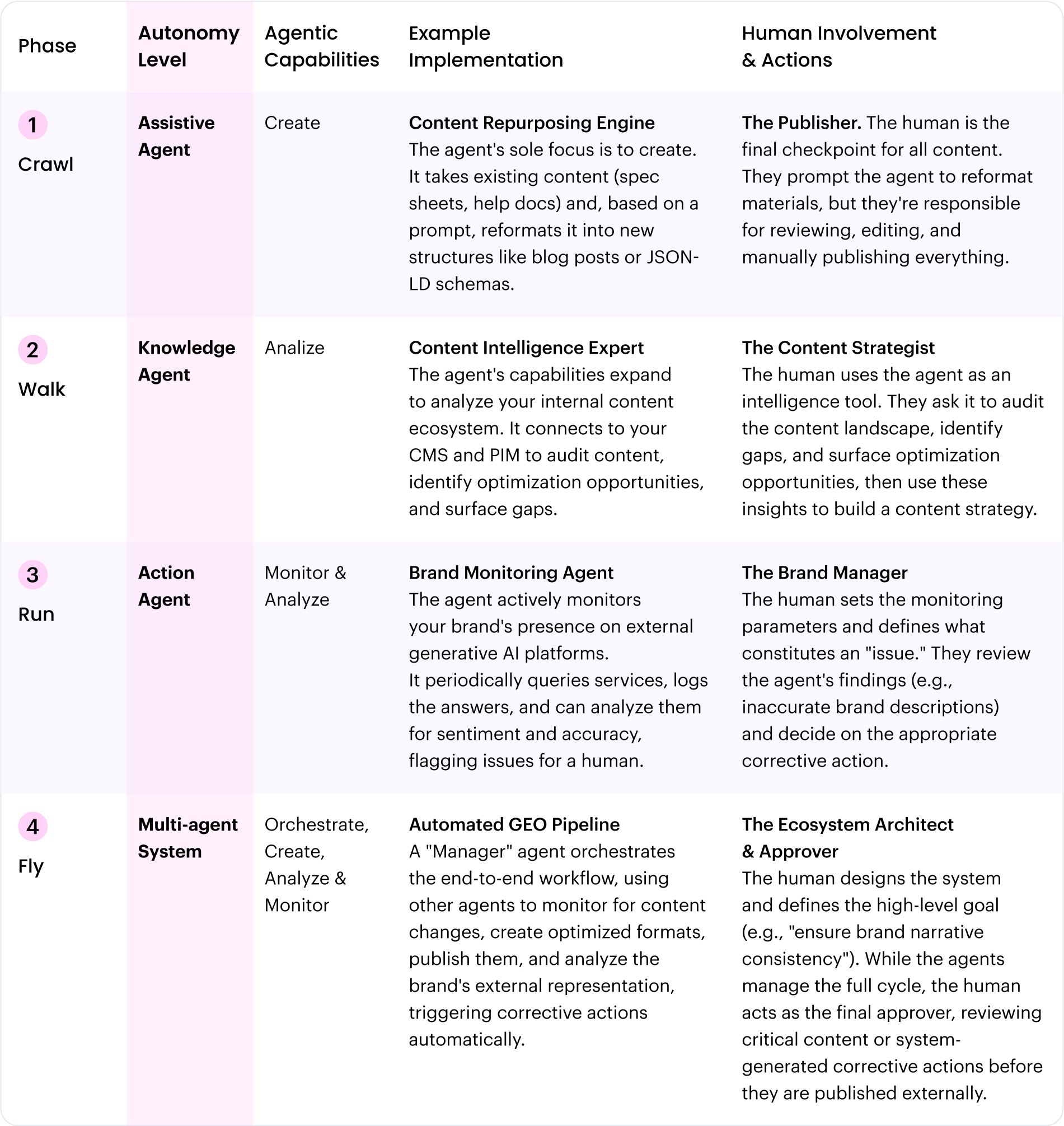
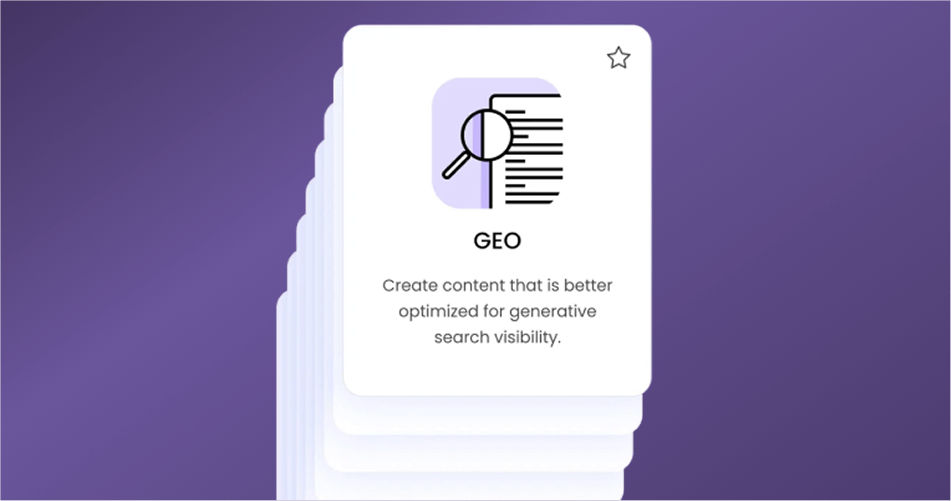
Win at generative search and GEO with WRITER AI agents
Learn More
End-to-end content creation
For any marketing team, creating high-quality, engaging content is the engine of growth. Yet, the traditional content lifecycle — from initial brief to final publication — is often slow, manual, and resource-intensive. This friction not only delays campaigns but also makes it difficult to maintain consistent brand messaging and voice at scale. By implementing an agentic AI workflow, teams can transform this process from a series of disjointed manual tasks into a streamlined, automated content assembly line.
This evolution allows marketing teams to accelerate the entire content lifecycle, freeing up talented humans to focus on strategy and creativity. Here’s how that journey maps to the Crawl, Walk, Run, Fly framework.
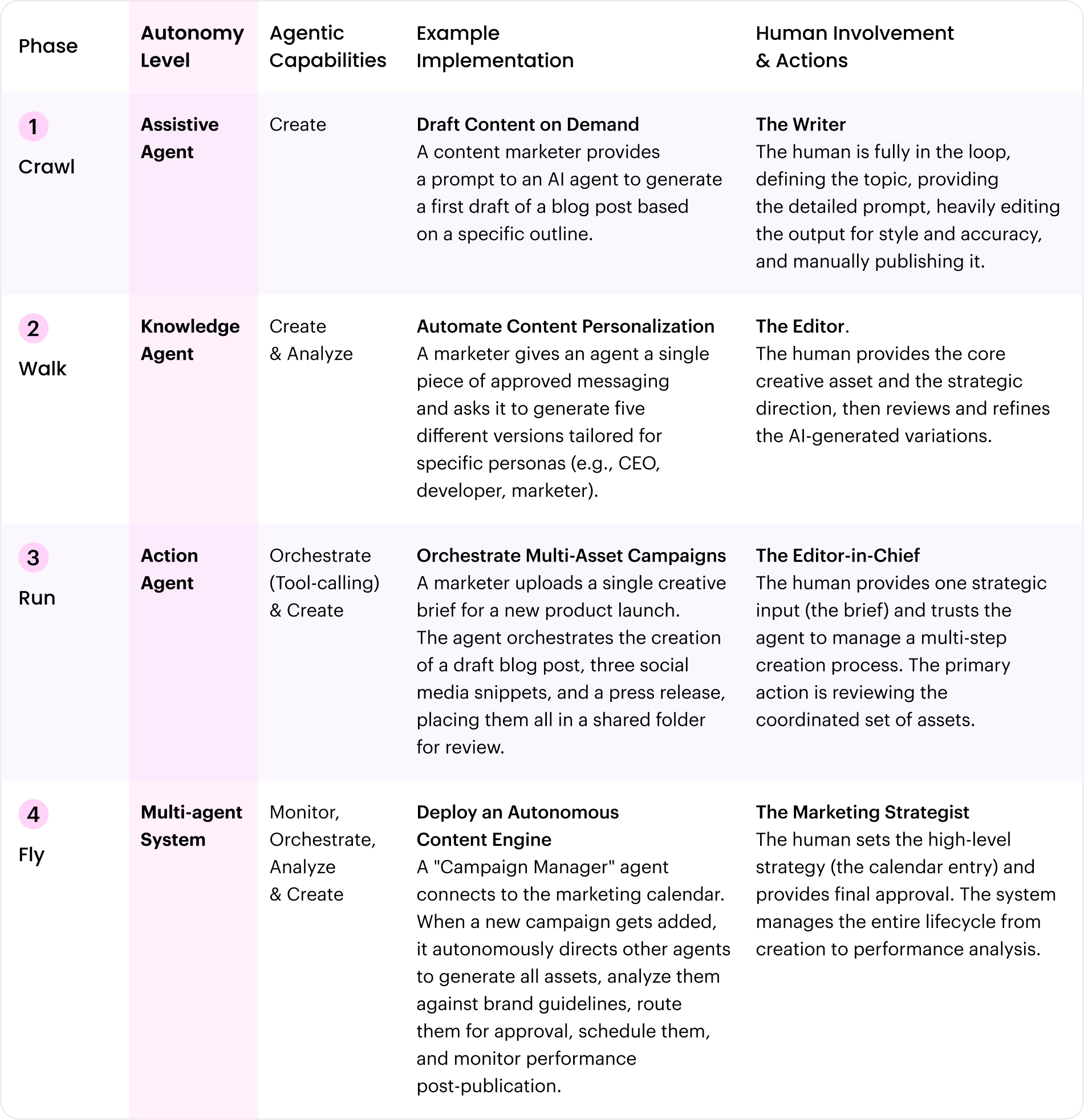
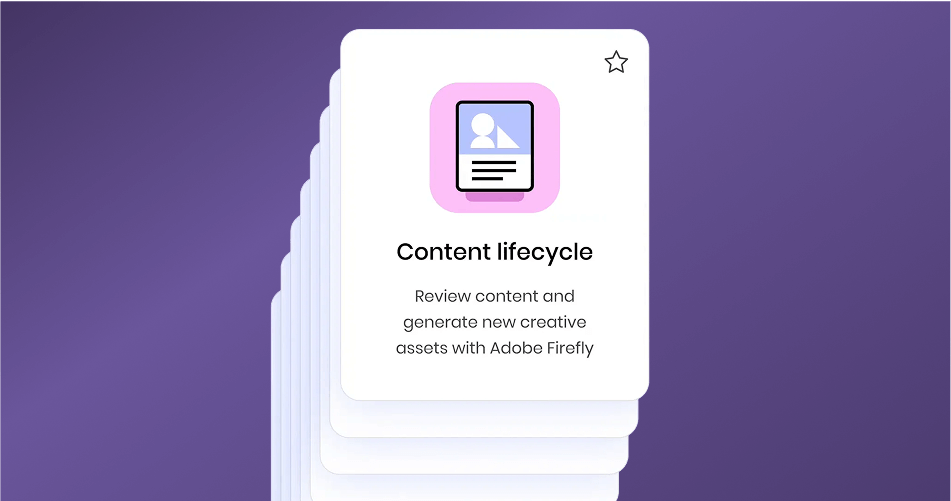
End-to-end content creation with WRITER AI agents
Learn More
Strategic guardrails for agentic marketing
To successfully integrate agentic AI into your marketing operations, you must pair the drive for personalization at scale with an unwavering commitment to brand integrity and customer trust. These guardrails ensure technology amplifies your brand, rather than diluting it.
- Protect the brand
An agent creating campaigns and content at scale can drift into an off-brand tone or generate inconsistent messaging, eroding brand equity with every output. Action: Equip the agent with a definitive “brand bible” as its source of truth, complete with locked-down voice principles, style guides, and approved messaging frameworks. - Respect the customer’s privacy
An agent optimizing for engagement can aggressively personalize to the point of being intrusive, violating customer trust and privacy regulations like GDPR and CCPA.
Action: Hard-code data usage boundaries and privacy rules into the agent’s operating parameters, ensuring all automated actions are compliant by design. - Unify the customer journey
Uncoordinated agents running separate campaigns can create a chaotic and disjointed customer experience, sending conflicting messages across different channels.
Action: Mandate that all agent-led interactions are logged and checked against a central customer data platform (CDP), ensuring a single, coherent journey for each person. - Audit the campaign logic
An agent given budget authority can rapidly scale a flawed campaign based on a faulty A/B test or bad data, leading to significant wasted spend.
Action: Implement automated “circuit breakers” for ad spend and require human approval for any strategic pivots or budget increases above a set threshold.
The bottom line: Use agentic AI to execute marketing tasks, not to determine the brand’s identity.
Case study
MARKETINGThe 6sense content rebranding engine

When 6sense acquired another company, they faced a massive challenge — hundreds of digital assets, from blog posts to web pages, were suddenly off-brand. Manually updating this content would have taken months. Instead, this challenge became the catalyst for deploying an agentic AI solution that evolved from simple task automation to a sophisticated, autonomous content engine.
This journey maps directly to the Crawl, Walk, Run, Fly framework:
- Crawl: The journey began with a marketer using an Assistive Agent as a hands-on tool to rewrite a single blog post. The human acted as the “Doer,” providing the content, giving the prompt, and manually reviewing the output. The agent’s primary capability was simple creation.
- Walk: Next, a Knowledge Agent analyzes the full content repository and identifies all 1,000+ assets with outdated brand terms. The human shifted to a “Content Strategist” role, defining the strategic goal and trusting the agent to perform large-scale discovery.
- Run: Automation then took a major leap forward, which is where 6sense operates today. An Action Agent received a list of non-compliant blogs and a clear goal — orchestrate a multi-step workflow to create rewritten drafts and place them in a review folder. The human became a “Supervisor,” setting the rules and overseeing the process with a final review.
- Fly (The Vision): The next frontier is a fully autonomous Multi-agent System. This future state would involve a “Manager” agent that continuously monitors for new content, automatically triggering a team of specialized agents to analyze, rewrite, and stage it in the CMS. The human’s role would then be elevated to “Executive Approver,” providing only strategic oversight and final sign-off.
This journey shows how a single, overwhelming problem was broken down into a series of evolutionary steps. With WRITER, 6sense didn’t just acquire a tool — they cultivated a process that scaled with their needs, transforming a manual, time-consuming task into a strategic, autonomous advantage.
Sales
For most sales organizations, the primary bottleneck isn’t a lack of talent — it’s a lack of time. Sales reps are consistently bogged down by time-consuming administrative tasks like prospect research, data entry, lead qualification, and CRM updates. This administrative burden slows down the sales cycle and pulls them away from the critical, revenue-generating work of building relationships and closing deals.
The agentic leap empowers sales teams by deploying sophisticated AI agents that execute these workflows automatically. By handling everything from market analysis to lead routing, these agents liberate reps to focus on high-value strategic selling, transforming the entire go-to-market motion.
Here are three key sales use cases mapped to the Crawl, Walk, Run, Fly framework.
Competitive research
Your strategy is stuck in last quarter’s data, but the market moves in real time. By the time your team manually synthesizes market trends, competitor moves, and new tech, the window of opportunity has already closed, leaving you to react to the past instead of shaping the future. This is where an agentic leap changes the game. An autonomous research agent works 24/7 as your always-on strategic analyst, continuously monitoring thousands of sources to separate the signal from the noise. Instead of drowning in data, your team gets synthesized, actionable intelligence delivered directly to them, providing a real-time, comprehensive view of the competitive landscape. This empowers them to spot new market opportunities and counter competitor threats before they even fully materialize, transforming your strategy from reactive to visionary.
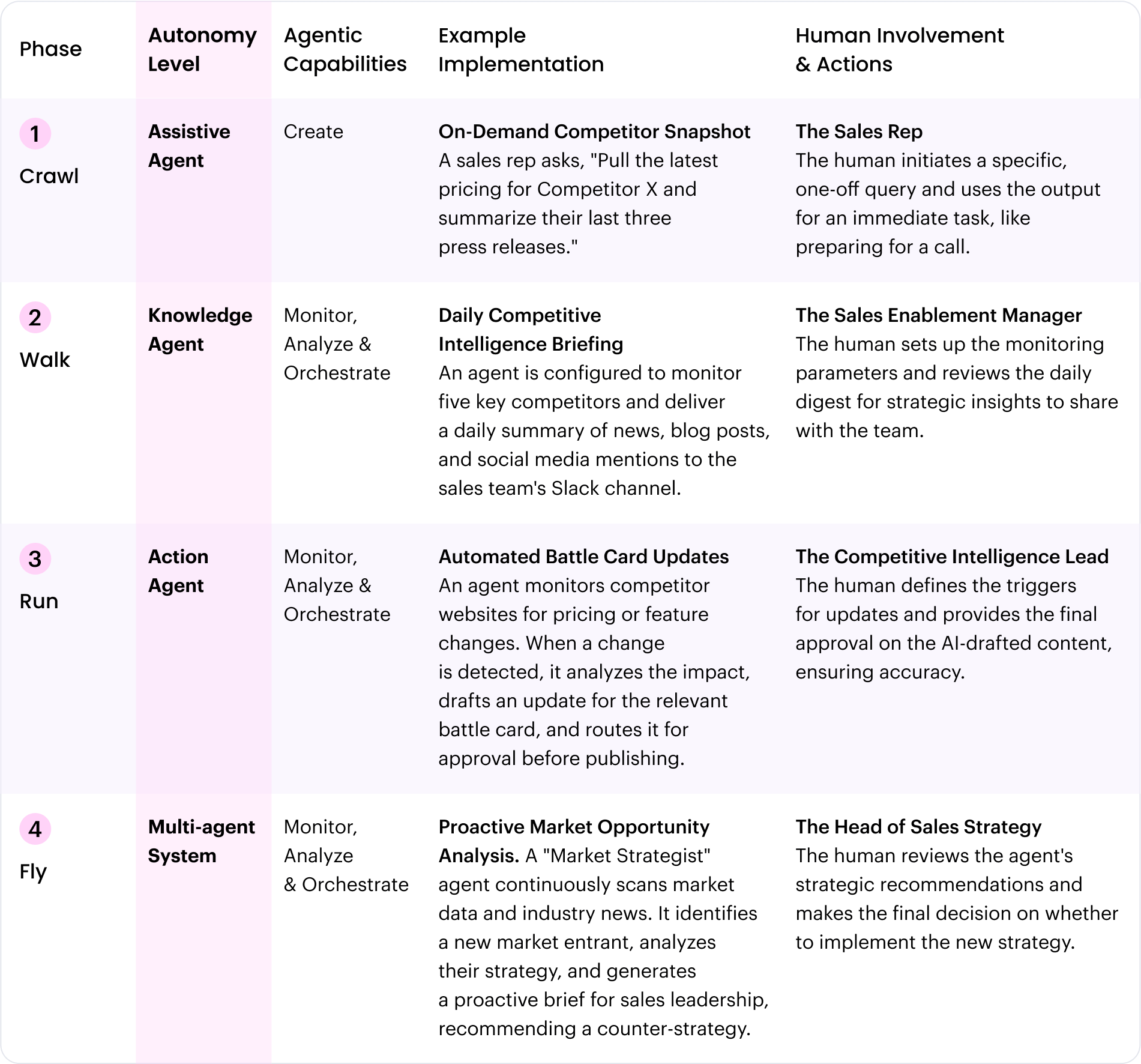
Lead development and routing
Hot inbound leads go cold in minutes. While your sales team wastes precious time manually sifting through unqualified prospects, your most valuable opportunities are already talking to a competitor. This friction doesn’t just slow down the sales cycle — it actively loses revenue. An autonomous LDR agent ensures no lead is ever left behind, flipping the script on this inefficiency. The moment a lead arrives, the agent instantly engages, qualifies, and scores it against your ideal customer profile. High-potential leads are immediately routed to the right rep with full context, while the agent nurtures the rest. This frees your sales team to focus exclusively on what they do best — building relationships and closing deals — and transforms your lead funnel from a bottleneck into a high-velocity conversion engine.

Field sales productivity
The most critical moment in a field sale is when the customer asks a question your rep can’t answer. The momentum dies, the deal stalls, and a confident pitch turns into a promise to “get back to you.” In that moment, your rep is an island, disconnected from the real-time data and expertise they need to win. An agentic partner changes this by putting your entire knowledge base in every rep’s pocket. It listens to customer interactions and proactively surfaces the right information at the right time — from competitive battle cards and customer history to complex product specs. It can even generate a tailored proposal on the fly, transforming every customer conversation into a strategic opportunity. This eliminates delays and empowers your team to close larger deals, faster.
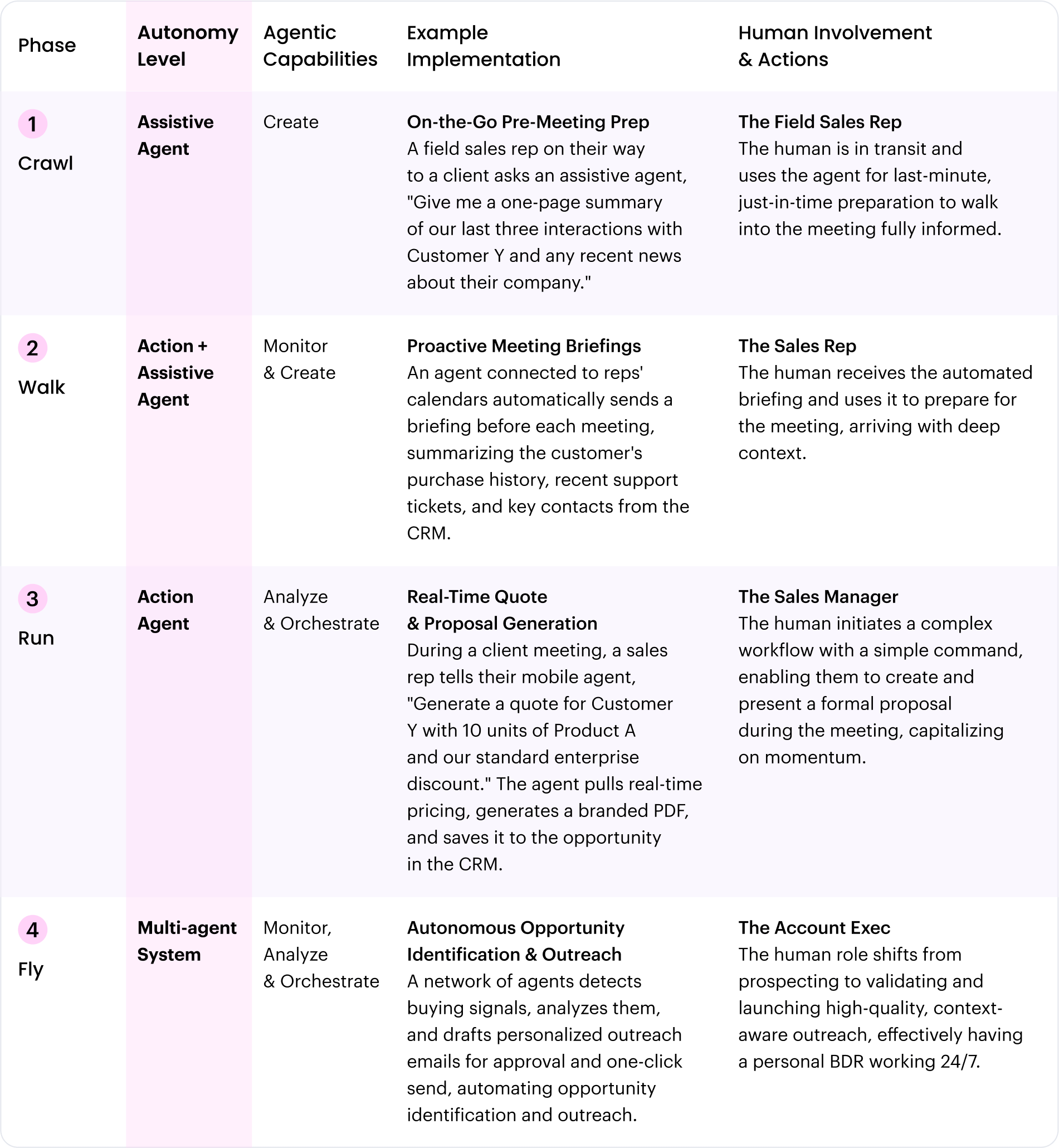
Strategic guardrails for agentic sales
To successfully integrate agentic AI into your sales organization, you must balance the pursuit of pipeline velocity with an unwavering commitment to building authentic customer relationships. These guardrails ensure technology empowers your reps, rather than replacing the trust they’ve earned.
- Preserve the human connection
An agent focused solely on quotas can engage prospects with overly aggressive or generic outreach, alienating potential customers and damaging the trust your sales team has built.
Action: Program the agent with strict “rules of engagement,” including communication frequency caps, personalization requirements, and the ability to immediately escalate to a human rep at any sign of customer friction. - Promise only what you can deliver
In its quest to close a deal, an agent might pull outdated product information or misrepresent capabilities, locking the company into promises it can’t keep.
Action: Lock the agent’s knowledge base to a single, verified source of truth for all product specifications, pricing, and contractual terms. Any deviation must require human approval. - Maintain data hygiene
An agent updating the CRM automatically can introduce inconsistent or inaccurate data, corrupting your pipeline and making forecasting unreliable
Action: Enforce rigid data entry formats and validation rules for the agent. Implement a regular audit process where humans spot-check agent-generated CRM entries for accuracy. - Protect your rep’s reputation
An agent communicating for a salesperson can adopt a tone or make a statement that misrepresents the rep’s personal brand and expertise
Action: Create a “digital twin” framework that allows reps to tune their agent’s communication style and requires that all high-stakes, agent-drafted emails get held for a final one-click approval by the rep.
The bottom line: Use agentic AI to handle the sales process, so your reps can focus on the sales conversation.
Case study
SALESThe Commvault sales enablement machine
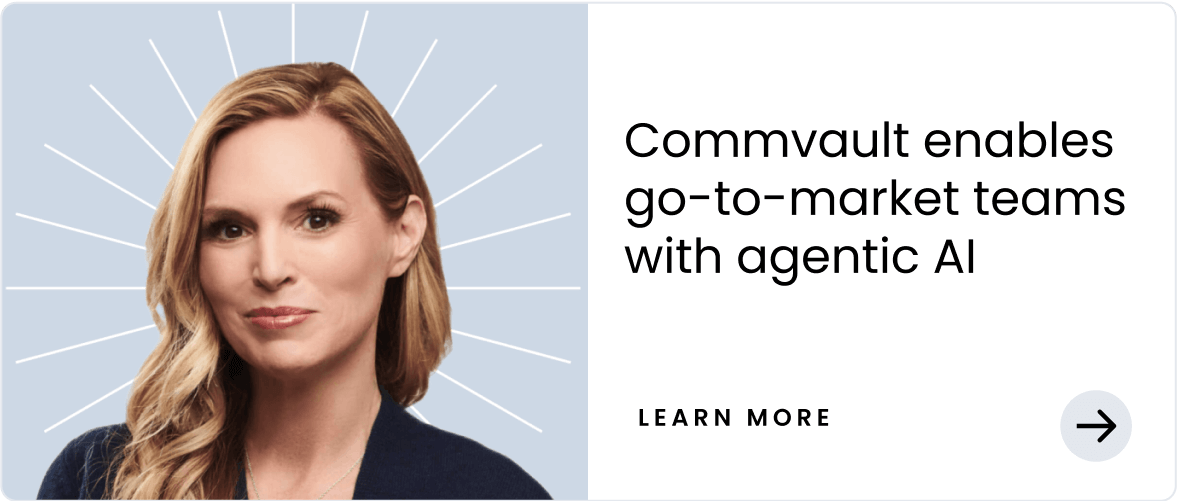
For enterprise sales teams, speed and accuracy are everything. But at Commvault, a leader in data protection, the sales force was struggling to keep pace. Finding the right information — from product specifications to competitive battle cards — was a time-consuming hunt through a maze of internal resources. This friction slowed down the sales cycle and risked inconsistent messaging.
The solution was to build an internal expert — “Ask Commvault Cloud,” a custom chat application powered by WRITER. This agentic AI tool became a central brain for the entire sales organization, transforming their workflow from a frustrating search to a simple conversation.
This journey maps directly to the Crawl, Walk, Run, Fly framework:
- Crawl: The journey began with a sales rep using an Assistive Agent to create tailored content. The human acted as the “Content Director,” prompting the agent to draft a specific email and then personalizing the output.
- Walk: This evolved into the core of their current solution, where a Knowledge Agent analyzed Commvault’s vast content library. Now, acting as an “Information Seeker,” a sales rep can ask direct questions like, “What are the key differentiators between our solution and Competitor X?” and get an instant, accurate answer.
- Run: The next step in automation involves an Action Agent that can orchestrate a complex workflow, like assembling a first-draft RFP response. The human becomes an “RFP Strategist,” initiating the process and reviewing the agent-generated draft for strategic alignment.
- Fly (The Vision): The Future Vision is a proactive Multi-agent System. This would involve an agent that continuously monitors market news and competitor updates, automatically generating and distributing intelligence briefings to the sales team. The human role is elevated to “Intelligence Consumer,” acting on curated insights without manual effort.
By shifting from manual search to an agentic conversation, Commvault empowered every rep to sell with speed and authority, turning a major bottleneck into a competitive advantage.
Support
Support teams face an impossible scale challenge — millions of customer inquiries, thousands of agents across time zones, and ever-growing knowledge bases that nobody can keep current or consistent. While agents spend precious time crafting the same responses over and over, customers wait for answers that already exist somewhere in the system. Meanwhile, knowledge bases become digital graveyards of outdated articles, and every new product launch requires massive manual effort to update help content across multiple platforms and regions. The expertise that should solve complex customer problems gets consumed by repetitive content creation and maintenance work.
The agentic leap empowers support teams by deploying intelligent AI agents that handle routine content creation and knowledge management automatically. By managing everything from help center articles to agent response generation, these agents free support professionals to focus on complex problem-solving, strategic improvements, and the nuanced customer interactions that actually drive satisfaction and loyalty.
Here are three key support use cases mapped to the Crawl, Walk, Run, Fly framework.
Help center content creation and management
Help centers become outdated the moment they’re published, and keeping them current across multiple products, regions, and languages is a never-ending battle. Support teams manually write new articles for every product feature, update existing content when policies change, and try to maintain consistency across thousands of help documents while dealing with urgent customer issues. This reactive approach means customers often find incorrect information, agents waste time directing people to outdated articles, and valuable support knowledge remains trapped in ticket resolutions instead of being systematized for reuse. An autonomous content management agent transforms this process by automatically generating help articles from internal documentation, updating content when products change, and ensuring consistency across all customer-facing materials.
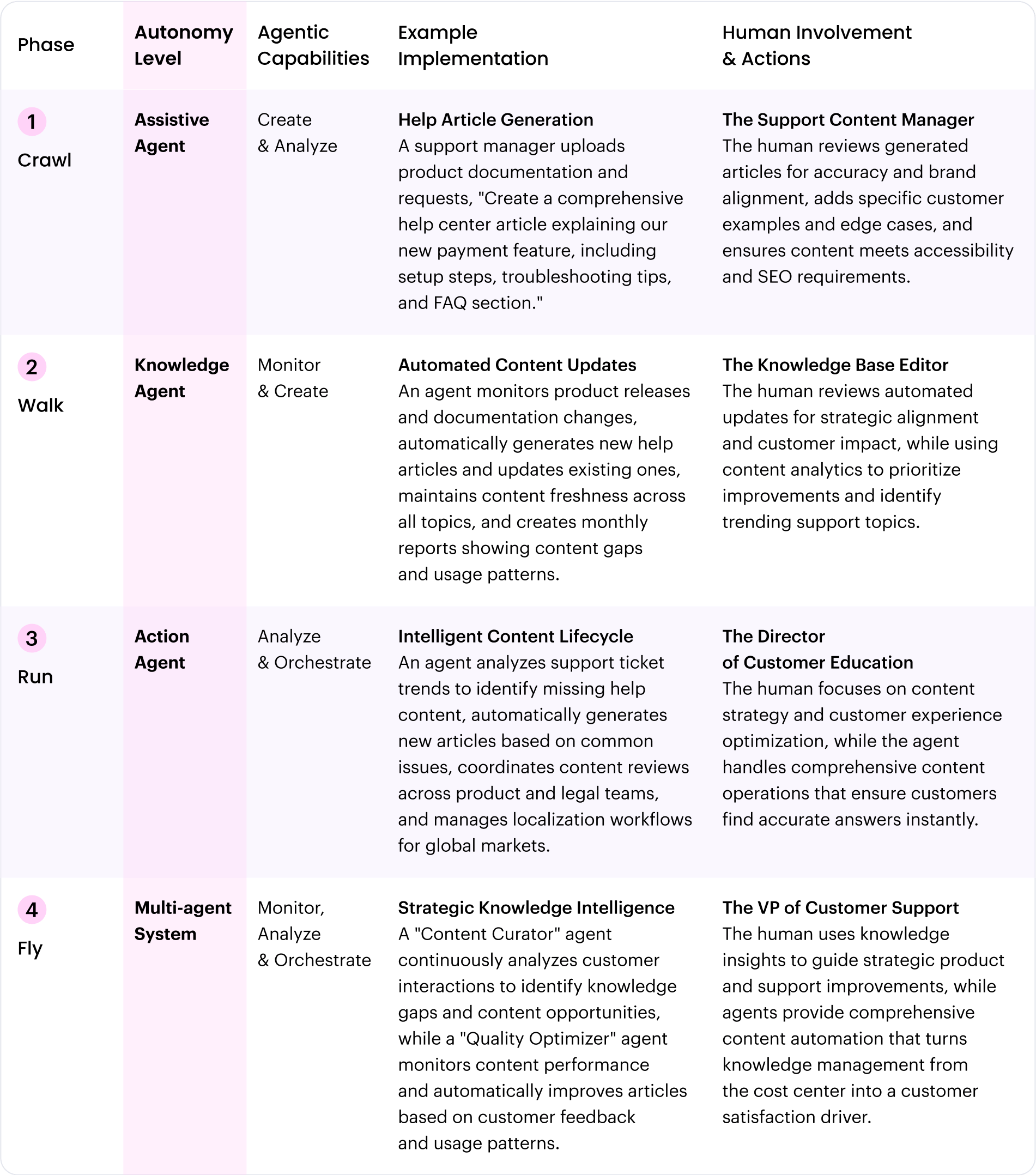
Support agent enablement and response generation
Imagine every support agent starting from scratch to reply, causing inconsistent quality, delays, and confused customers getting different answers to the same questions. Not exactly a smooth ride. Traditional support relies on agents manually searching through knowledge bases, copy-pasting from saved responses, and spending valuable time writing custom replies that often miss key information or don’t match company tone and compliance requirements. This approach doesn’t scale when you have thousands of agents across different regions, languages, and expertise levels. An autonomous response generation agent transforms this dynamic by providing agents with high-quality, contextually appropriate responses that maintain brand consistency while adapting to specific customer situations and regional requirements.
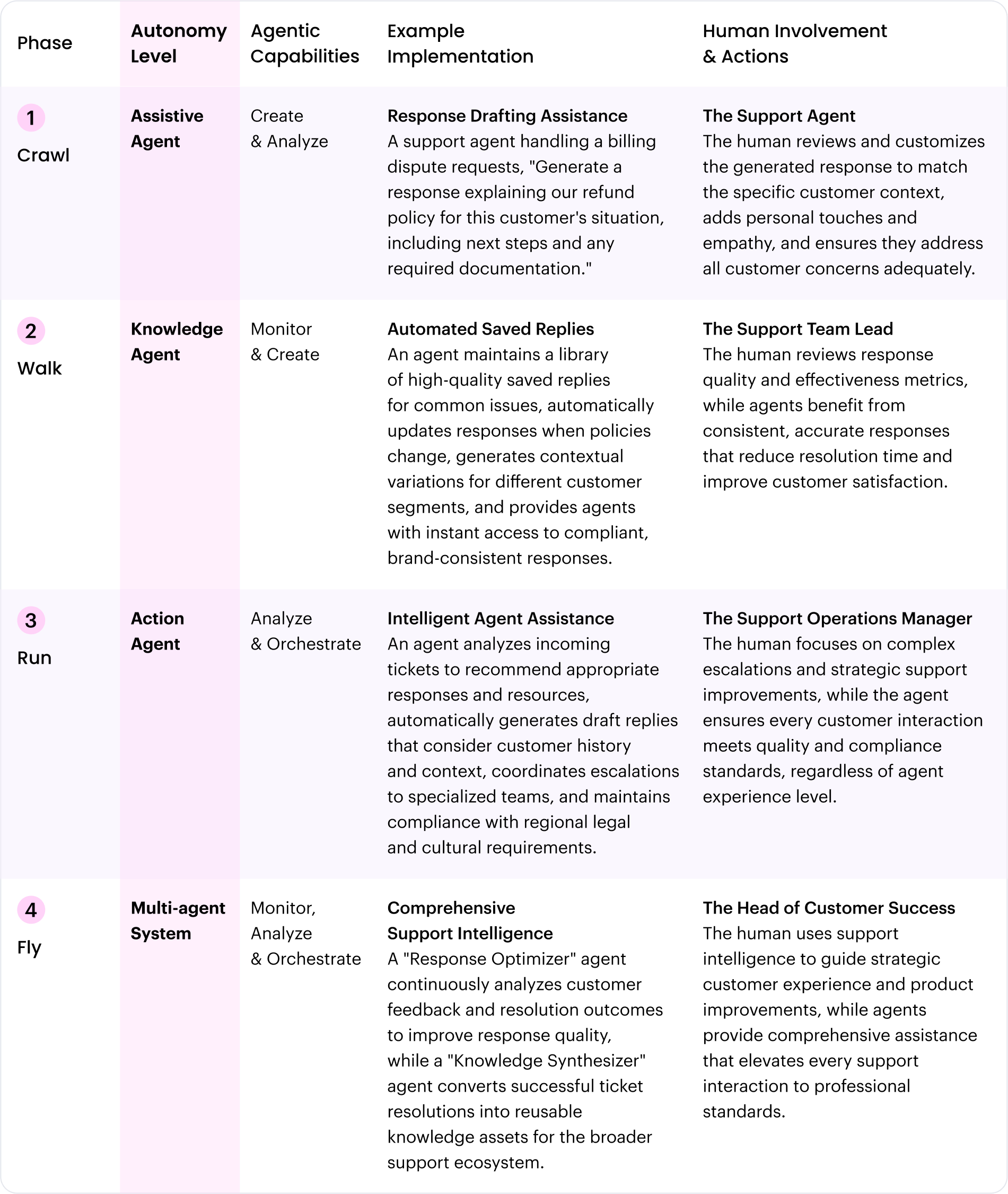
Support insights and trend analysis
Support teams sit on a goldmine of customer intelligence, but most of it remains buried in individual tickets and conversations that never get analyzed for broader patterns. Traditional support operations are reactive — teams respond to issues as they arise without understanding underlying trends, product problems, or customer sentiment patterns that could inform strategic improvements. Meanwhile, valuable insights about customer pain points, feature requests, and emerging issues remain invisible to product and business teams who could act on them. An autonomous insights agent transforms support from a reactive cost center into a proactive intelligence engine that identifies trends, predicts issues, and provides actionable insights that drive product and business strategy improvements.
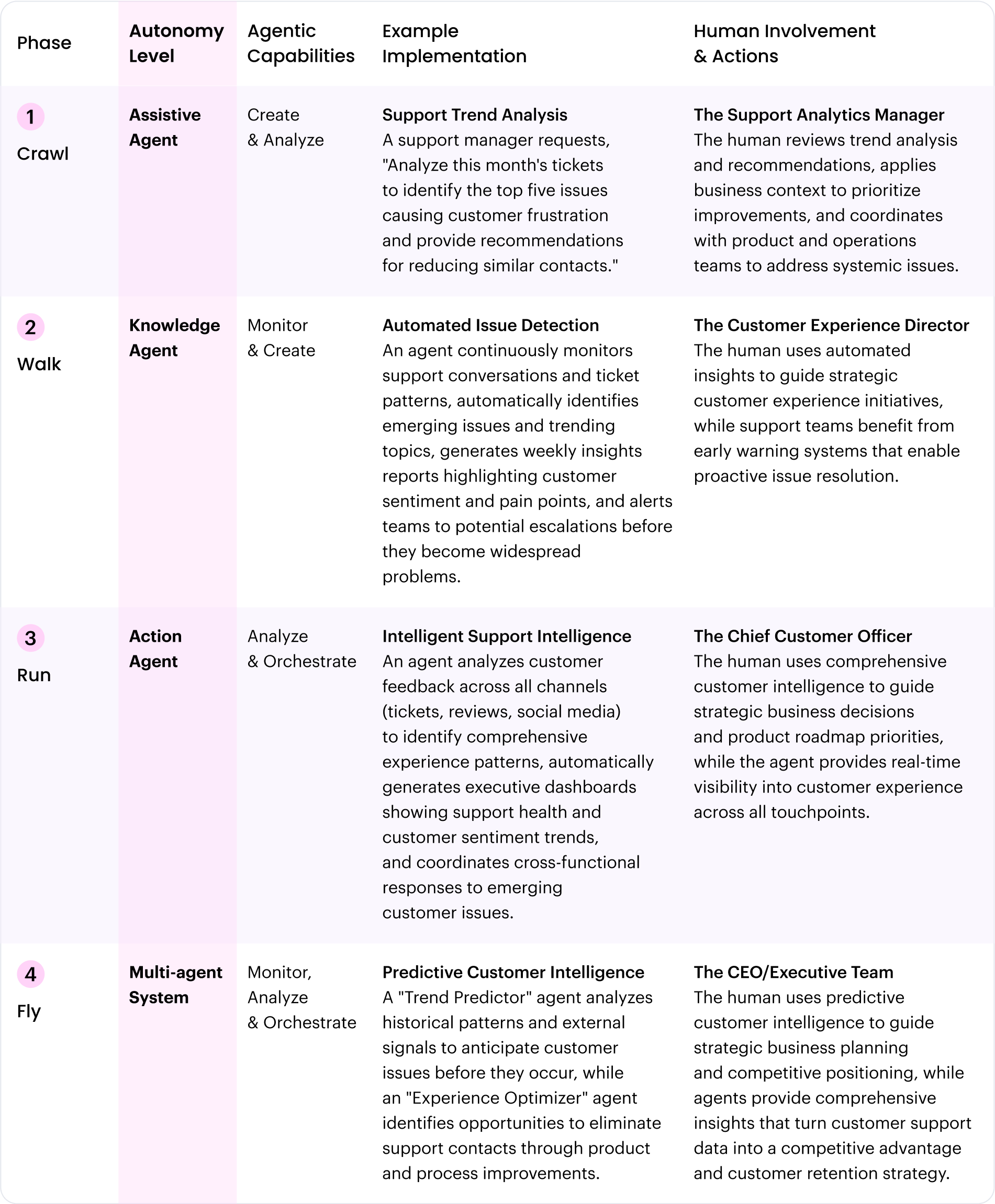
Strategic guardrails for agentic support
Integrating agentic AI into your support operations requires striking a balance between efficiency and a steadfast commitment to customer empathy and contentment. These guardrails ensure technology provides faster resolutions without sacrificing quality of care.
- Prioritize empathy over efficiency
An agent optimized solely for ticket closure time might use blunt, unhelpful language or close a ticket before truly resolving the customer’s issue, turning a simple query into a major complaint.
Action: Program the agent with sentiment analysis to detect customer frustration. Set a primary KPI for customer satisfaction (CSAT) scores over ticket resolution time, and automatically flag any interaction with negative sentiment for immediate human review. - Ensure a single source of truth
An agent could provide conflicting or outdated information by pulling from multiple, unverified knowledge sources, leading to customer confusion and incorrect troubleshooting that makes the problem worse
Action: Restrict the agent’s knowledge base to a single, continuously updated, and human-verified repository. Implement a process where the agent flags content that seems outdated or leads to negative customer outcomes. - Define clear escalation paths
A customer with a complex or novel issue can get stuck in an “automation loop,” unable to reach a human who can actually solve their problem, leading to extreme frustration.
Action: Establish strict rules for automatic escalation. If the same question gets asked twice, if negative sentiment is detected, or if the issue involves specific keywords (e.g., “billing error,” “security”), the agent must immediately hand off the conversation to a specialized human agent. - Capture and analyze customer friction
By automating away simple queries, you risk losing a critical source of data about common user problems and friction points that could inform product improvements.
Action: Task the agent with not just answering questions, but also categorizing and logging every interaction. Create a dashboard that surfaces trends in customer issues, allowing the product and engineering teams to proactively address root causes.
The bottom line: Use agentic AI to resolve the known issues, so your support team can focus on the unknown and complex ones.
Case study
SUPPORTHow Uber tamed 5 million knowledge assets
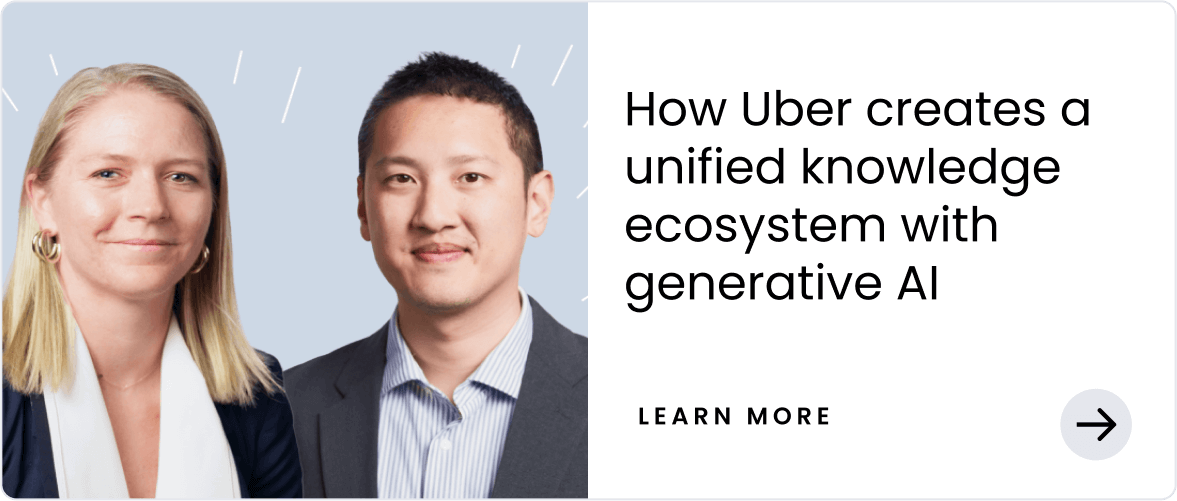
For Uber, managing support content at a massive scale had become an unsustainable challenge. With over 5 million knowledge assets and 40,000 support agents worldwide, Uber struggled to deliver consistent, compliant answers to millions of customer inquiries. Teams spent countless hours manually writing saved replies and help center articles, leading to inconsistent quality, slow updates for new products, and a constant risk of non-compliance with ever-changing regional regulations. Valuable knowledge remained siloed in individual tickets, and the support content ecosystem was too fragmented to scale.
The solution was to deploy a knowledge agent that could automatically generate high-quality, compliant support content. By analyzing internal documentation and successfully resolving tickets, the agent learned to produce contextually appropriate saved replies and help center articles. Crucially, this agent was integrated directly into Uber’s support team’s existing workflow in Google Sheets, allowing them to generate content with the touch of a button without learning a new tool.
This journey maps directly to the Crawl, Walk, Run, Fly framework:
- Crawl: The process could have started with an Assistive Agent that simply suggested relevant phrases or sentences from a knowledge base. A support agent, acting as the “Assembler,” would have manually pieced together the final response.
- Walk: Uber implemented a Knowledge Agent that monitored successful ticket resolutions and created complete, ready-to-use drafts of saved replies and articles. The Support Content Team, acting as the “Reviewer,” shifted their focus to strategic alignment and final approval.
- Run: The next stage is an Action Agent that not only creates content but also optimizes it by analyzing customer feedback and automatically orchestrates updates across all platforms and languages simultaneously. The support operations manager, acting as the “Process Supervisor,” would oversee the automated system’s performance.
- Fly: Where can they go next? A multi-agent system where a “Predictive Content” agent anticipates support needs based on product roadmaps, while an “Experience Optimization” agent identifies opportunities to eliminate support contacts through proactive education. The head of customer experience, acting as the “Strategist,” would use these insights to shape global support policy.
By automating the creation of first drafts, Uber transformed its support operations. Teams can now generate consistent, compliant content instantly, ensuring that new product launches have support from day one. This shift dramatically improved the quality and consistency of customer interactions while freeing the support team to focus on higher-value strategic work, turning a reactive cost center into a proactive driver of customer satisfaction.
The future is agentic: How to get started
The shift from task-based generative AI to comprehensive workflow automation isn’t just on the horizon — it’s here. As we’ve explored, the real competitive advantage lies not in completing individual tasks faster, but in orchestrating complex, end-to-end business processes with AI agents. This is the dawn of the agentic enterprise, where AI workflow automation powers entire functions, data silos no longer exist, and teams are empowered to focus on high-value strategic work.
But building these powerful, secure AI agents requires an end-to-end platform designed for the enterprise. This is where WRITER comes in. We provide the only platform that allows you to build and deploy AI agents with the security, data privacy, and brand consistency that enterprise leaders demand. Our platform connects seamlessly with your existing business systems, transforming your proprietary data into a competitive advantage.
Build your own AI agents with WRITER
It’s time to move from theory to practice. With WRITER, you can build and deploy the very agents described in this guide, securely within your enterprise environment. Our AI HQ provides a central hub for managing your models, data, and applications, while Action Agent empowers you to design and launch custom agents that orchestrate, create, analyze, and monitor workflows across your entire organization.